Pre-parenthood, I always heard stories of babies that could swim before they crawled or run before they walked.
It seemed that babies were built with instinctive reflexes that went beyond sucking or smiling—reflexes combined with a lack of fear and low center of gravity, two great advantages in the world of snowsports.
But how young can you teach a kid to snowboard, and how would you do so yourself?
I’ve seen tiny skiers bop their way down the bunny hill as young as two years old, and marveled as mini rippers seemed to get younger and younger with every YouTube video I watched.
One friend put his son on a snowboard at 18 months, and another friend started his daughter at 12 months. These toddlers were barely stable on their feet, yet solid on their boards as their parents pushed and pulled them across the snow.
For parents like us, it’s an amazing time to share our love of sliding sideways with our little ones. The gear gets smaller and better each year, to the point where my husband jokingly says he can hang the baby’s goggles off his rearview mirror.
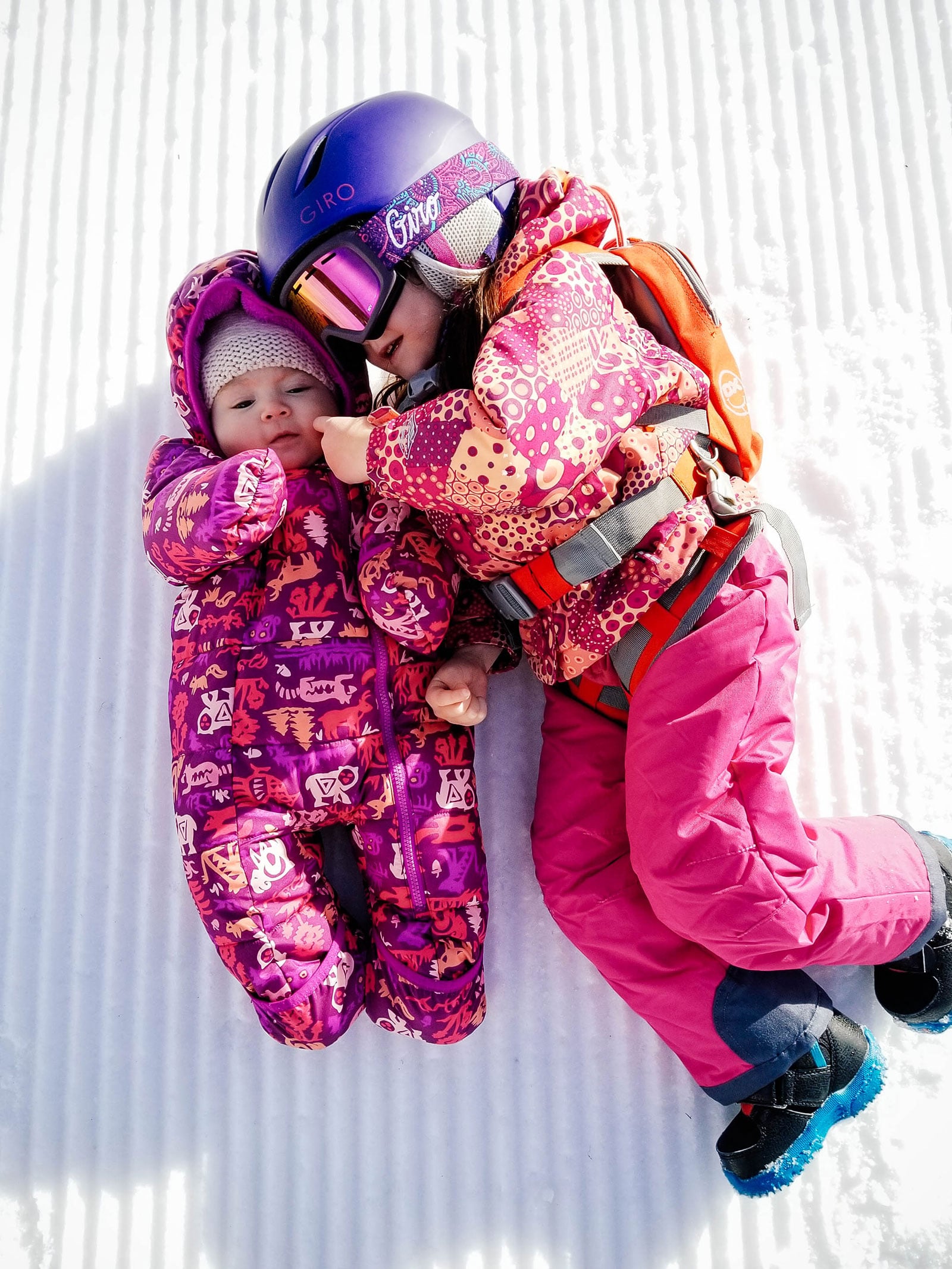
Our story of teaching our young daughter to snowboard
When our first daughter Gemma was born, we knew we’d introduce her to snowboarding as soon as she could stand. (After all, she got her first taste of it at eight months in utero!)
And I suppose we’d been prepping her for that day since birth. She loved to be tossed in the air and hung upside-down, and some of her favorite days involved sitting outside eating snow.
There was no doubt she was ours: a curious, alert, outdoor-loving adventure-seeker.
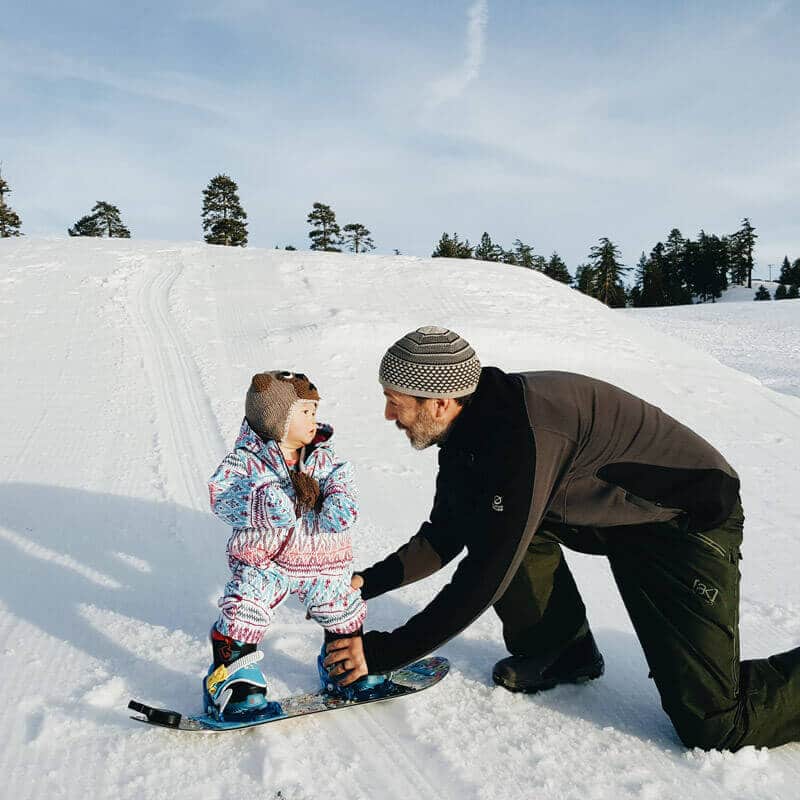
Avid snowboarders and skiers always say, “Start ’em young!”
And start ’em young we did—at just 10 months old, we strapped Gemma into her very own snowboard and towed her around for a good 20 minutes until she started to fuss for a nap.
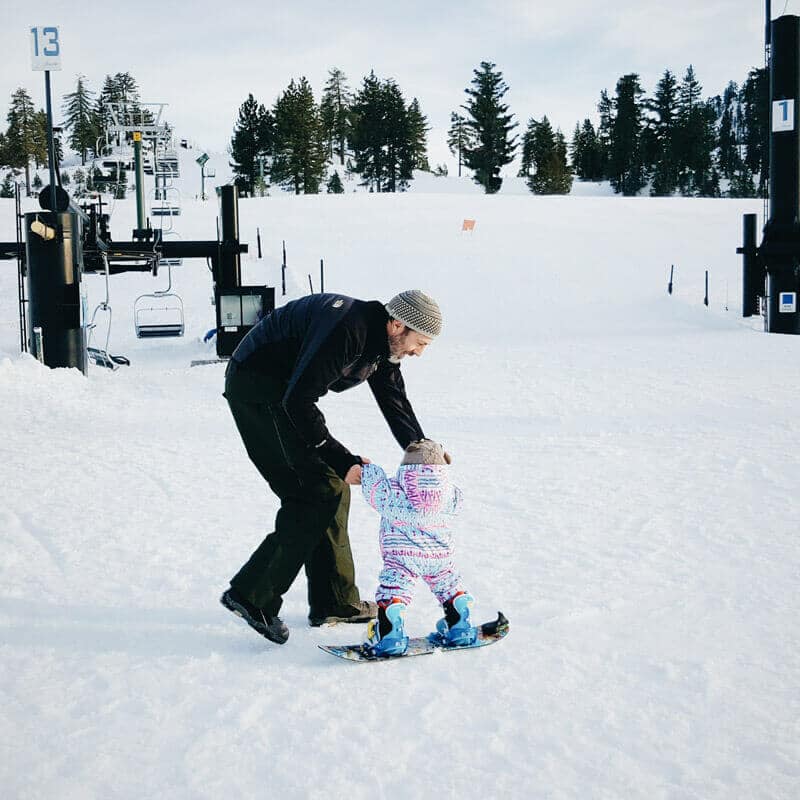
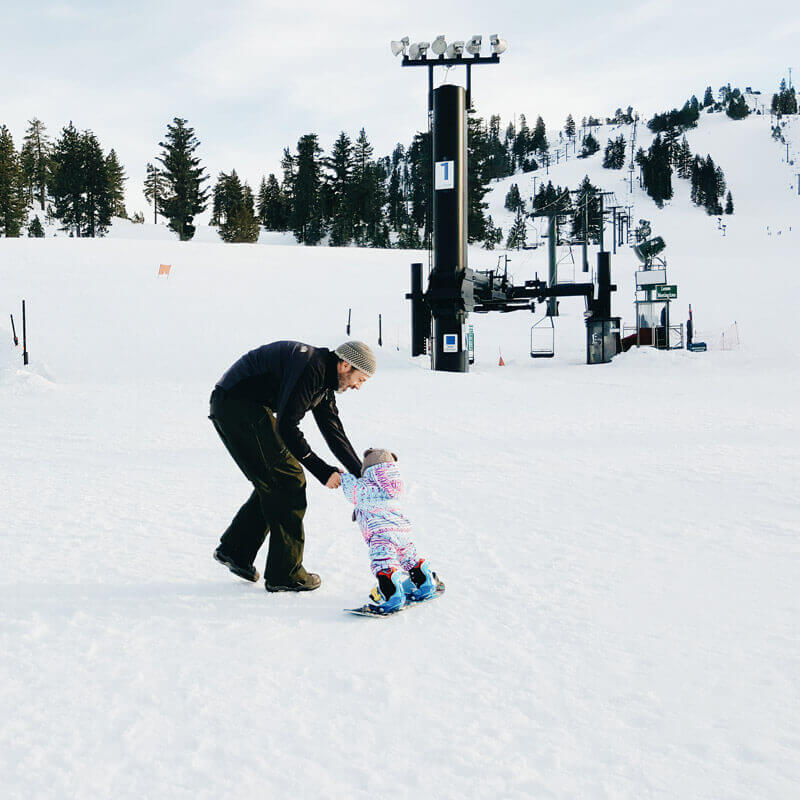
She loved it. And admittedly, she couldn’t even walk on her own at that point. (She was starting to cruise though.)
The toddler-sized snowboard boots went up so high on her legs (almost to her knees!) that they naturally locked her in position, allowing her to balance as we pulled her around the base of the mountain.
I was such a proud mama to see other skiers cheering her on!
Now that she’s 7 years old, Gemma’s making S-turns down the mountain by herself. She passed on her old snowboard to her 4-year-old sister Ember, who strapped in for the first time at 14 months old. This year, Ember will be entering her fourth season snowboarding, with Mom and Dad as her instructors.
Have we learned any tricks from the first round? Definitely!
Here’s our experience with teaching babies and toddlers how to snowboard and having fun doing it.
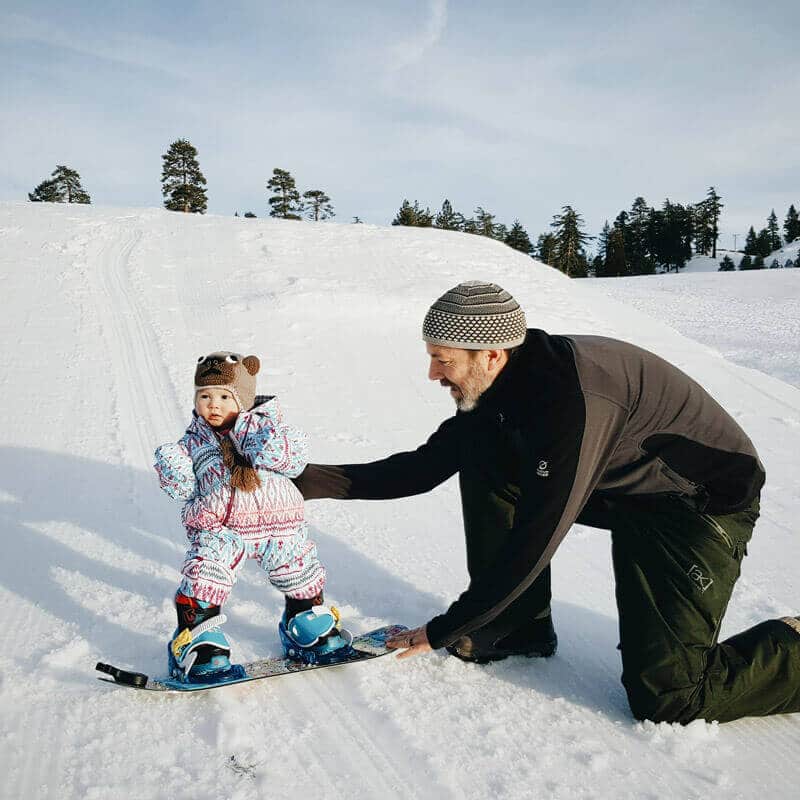
Should kids learn to ski or snowboard first?
As a family of snowboarders, we knew we wanted our kids to snowboard with us. My husband and I do ski (we especially enjoy cross-country skiing), but neither of us had a real desire to do downhill skiing again anytime soon.
Since we were teaching the kids ourselves, we felt it was easier to teach them not only how to snowboard, but to snowboard goofy-foot. (Which we both are.)
This way, everyone could get off the lift facing the same direction, the kids could mimic our moves, and honestly, we’d have less equipment to carry!
If both parents snowboard, it just makes sense (to us) for kids to learn how to snowboard. If one parent snowboards and the other one skis, then take your pick of what you’d like your child to learn first.
One day we’d love for our kids to take up skiing as a new challenge, but in these early years (since we’re teaching them), snowboarding is where we want to start.
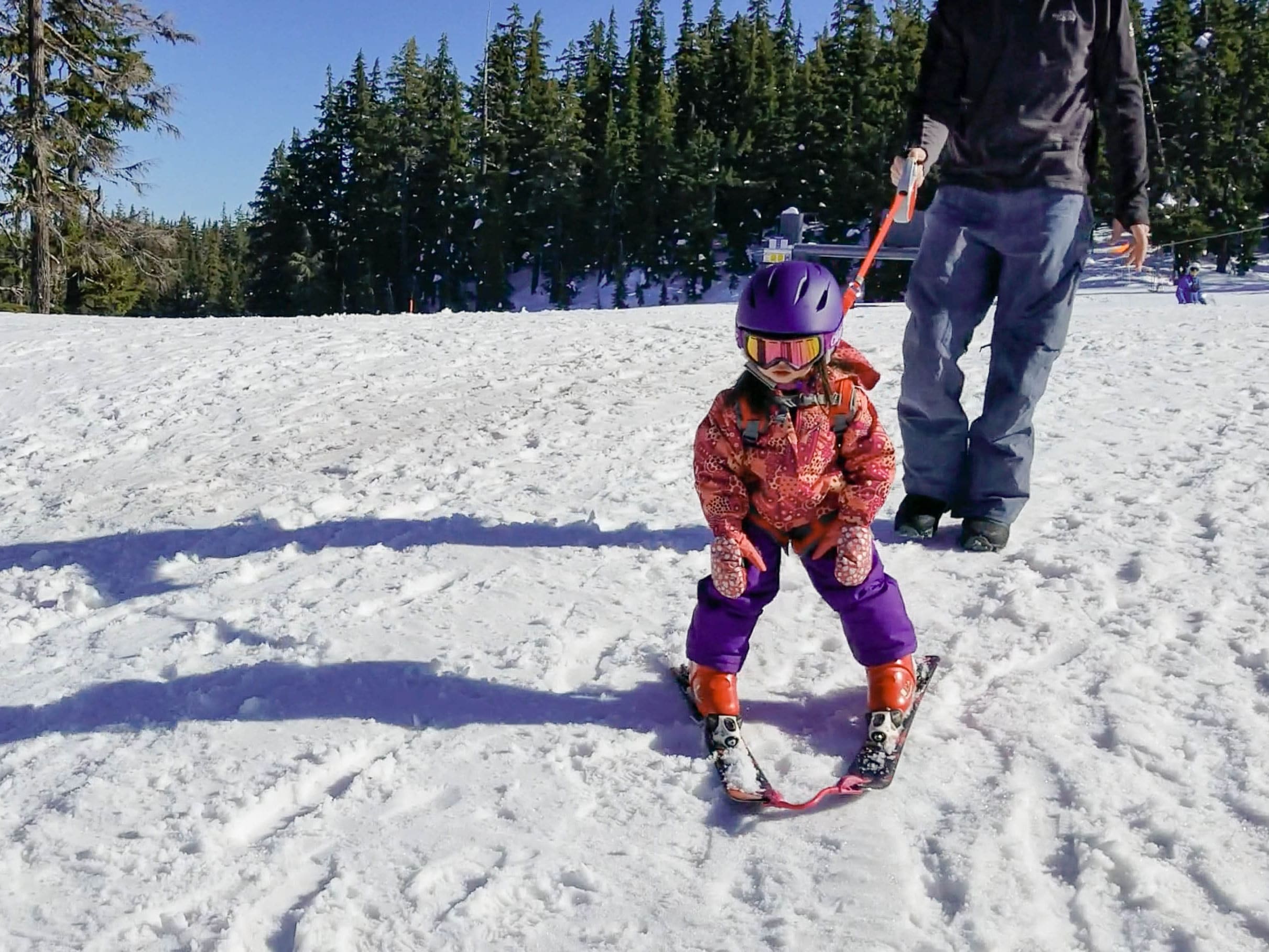
But isn’t it easier for a toddler to ski?
Yes, we hear it all the time: people insisting that it’s easier for kids to ski first.
Swayed by these opinions, I even bought a pair of secondhand skis for Gemma, thinking we’d teach her both activities and let her decide what she wanted to get into.
After a couple of downhill ski outings, she chose to snowboard because we snowboard and she wanted to be like us!
It’s a common misconception that kids have to learn how to ski first before transitioning to a snowboard.
That may have been true a decade ago, but with the latest advancements in snowboard tech for little kids and the right mindset, you can easily teach a child to snowboard as young as 2 years old.
(You can start even younger, like we did, though the actual teaching doesn’t begin until 2 to 3 years old when toddlers can begin to understand and follow some basic instruction.)
In my opinion, it doesn’t matter if you start with skiing or snowboarding first. Go with the one that feels easier for you to teach! Since kids are developing so rapidly in these early years, they pick up motor skills quite fast.
One thing I will add, however, is that the skiing versus snowboarding debate is the same for kids as it is for adults. That is, skiing is very easy to pick up at first (since you stay upright more often), but it’s harder to master proper technique and black-diamond skills.
Snowboarding, on the other hand, is a little more challenging to learn in the beginning, but much faster and easier to get to an advanced level of riding.
When it comes to little kids, I feel these points are moot because they’ll always get better by starting so early!
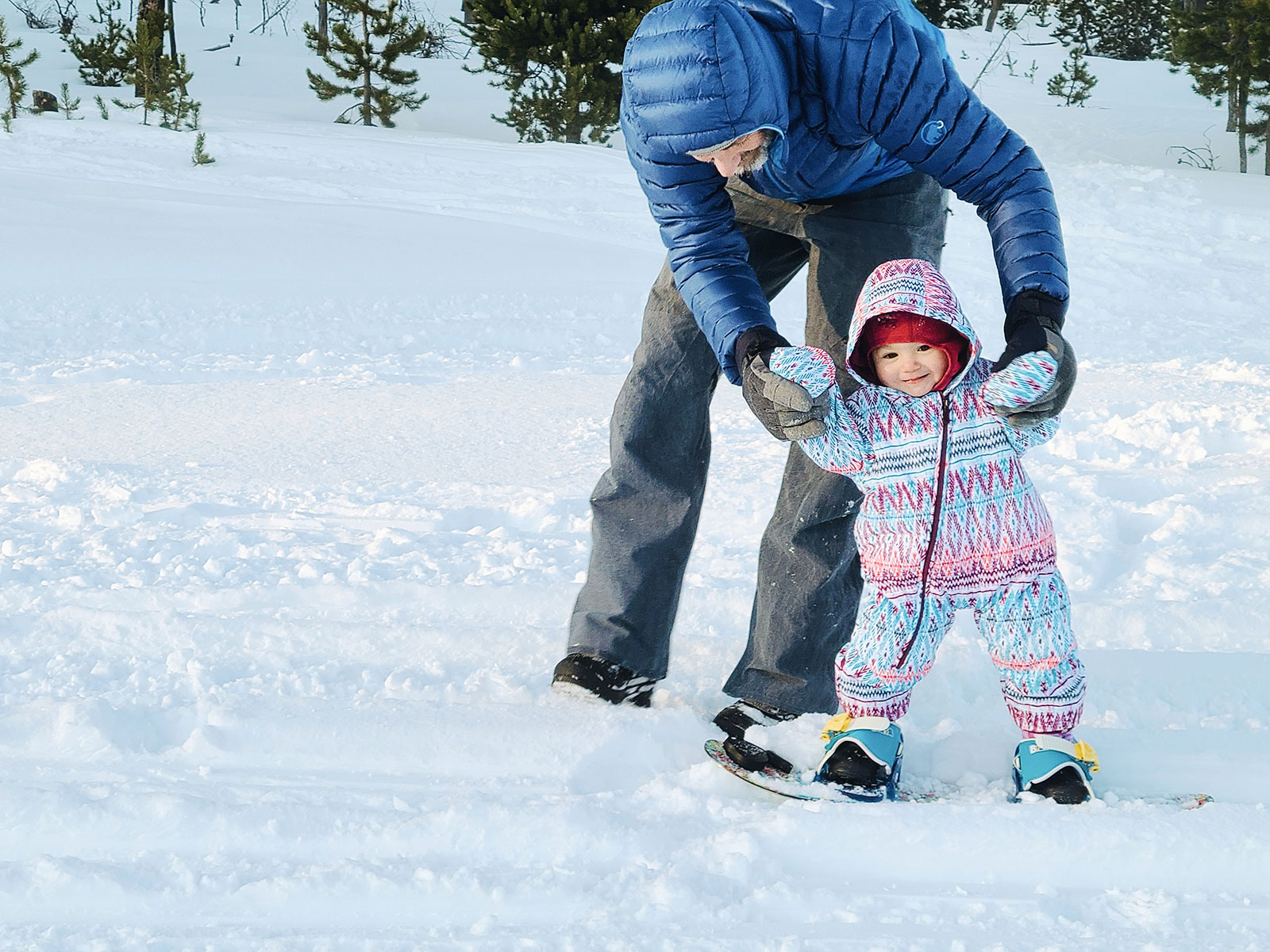
What’s the right age for a child to start snowboarding?
This will depend on the child.
For our family, we felt our kids were ready to start playing on a snowboard by the time their first winter rolled around. Our first daughter was 10 months and our second daughter was 14 months when this happened.
Ideally, kids should be walking (or at the very least, cruising and exploring their kinesthetic abilities by climbing, twisting, and rolling around) before you strap them into a board.
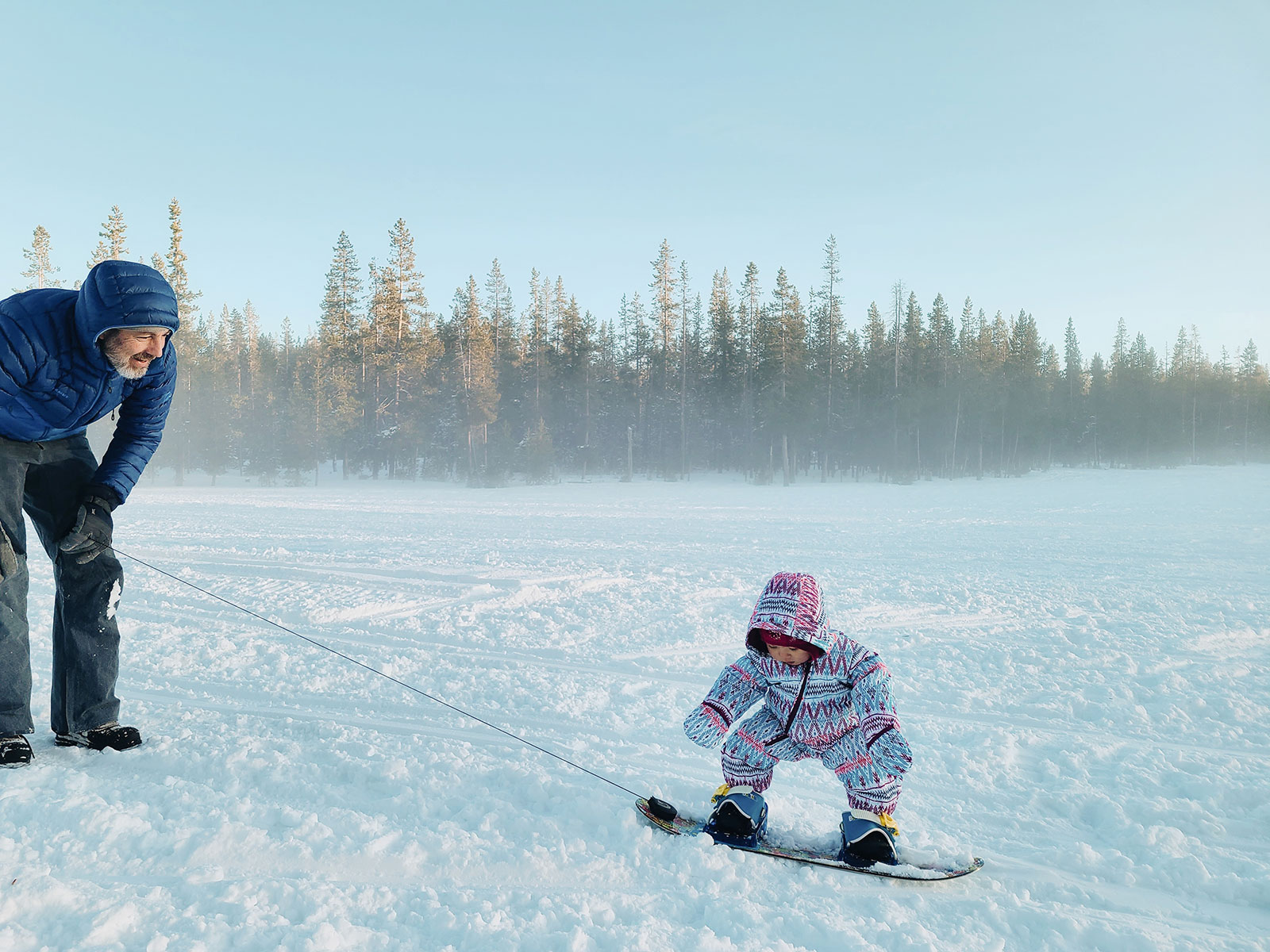
Can you actually teach a baby to snowboard?
Babies and toddlers are masters of the squat, so it comes naturally for them to crouch into that position on a snowboard, with no instruction at all.
The same muscles that help them do “pizza” on skis also help them put pressure on a heelside edge to stop a snowboard.
If you’re starting young, you pretty much have no choice but to teach babies and toddlers yourself. Most resorts don’t give lessons to kids younger than 3 (unless they’re fully potty trained), and some places require them to be at least 5 years old for snowboard lessons.
The good news is, it’s very easy to teach a baby or toddler to snowboard if you have the right gear.
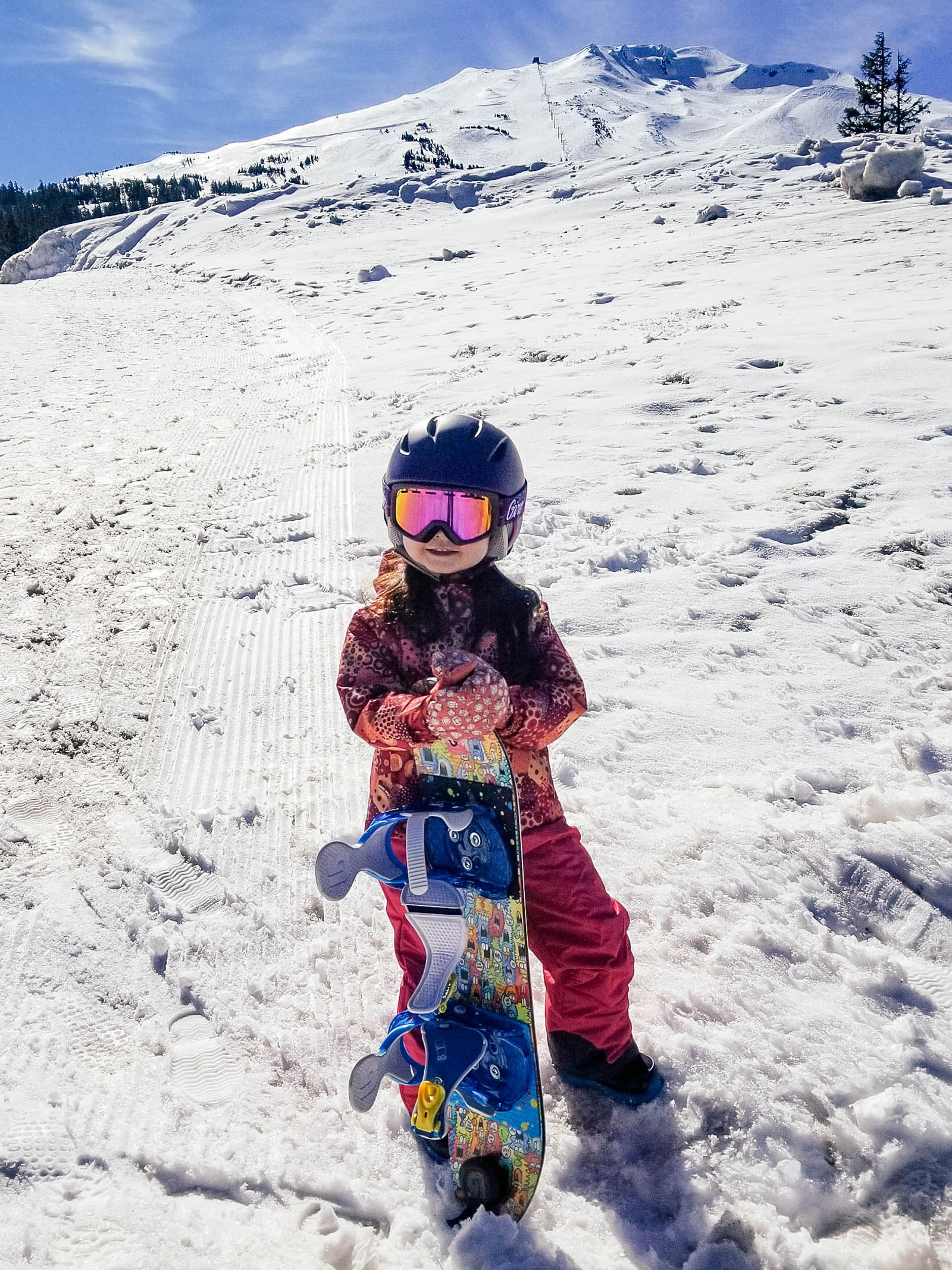
What kind of gear do you need to teach kids to snowboard?
For the smoothest experience on the hill for everyone, proper gear is essential and it starts with keeping your kids warm and dry.
Fact is, your little ones will be much happier (and agree to stay out longer) if their fingers aren’t frozen or their baselayers soaked in sweat.
Here’s a post I wrote about dressing a baby and toddler for cold winter weather. The main takeaways are: no cotton, and layers are key! (I call it the Baby Sandwich.)
As far as hardgoods go (snowboards and accessories), kids will probably outgrow their board after two seasons, so hand-me-downs are great since they’re usually very gently used.
But, getting the right size is important.
Too small a board, and your kid’s stance might end up too narrow to keep him stable. Too large, and it could be cumbersome to put the snowboard on edge (not to mention your child’s legs might be too splayed).
Sometimes I luck out at our local outdoor-gear consignment shops, but I think the best places to hunt for toddler snowboards are Facebook Marketplace or Craigslist if you live near a resort or in a big city, or on eBay if you’re far from the mountains. Typically, people start unloading their old gear in late spring and early winter so they can get new gear.
Disclosure: If you shop from my article or make a purchase through one of my links, I may receive commissions on some of the products I recommend.
Snowboards and bindings
Burton is my go-to for toddler-sized snowboards, which start at 80cm and fit an average-sized 2-year-old. I’ve always gotten the Burton Mini Grom Rocker snowboard.
If you’re finding your desired size out of stock, you’re in luck. In the seven years since we started teaching our toddler, other outdoor brands have stepped up and released their own pint-sized snowboards. Here’s a great selection of boards from 75cm to 95cm, all from reputable brands like K2 and Rome.
These snowboards are designed to minimize edge catches and help with turns, so they’re super kid-friendly (especially when your kids are too young to understand what catching an edge means).
Our first daughter (who’s slightly above average in height) used an 80cm board from ages 10 months to 4 years. Once she turned 4, we moved her up to a 100cm board.
We never once tuned or waxed the 80cm board the whole time we owned it. (We honestly didn’t need or want our groms to go any faster!)
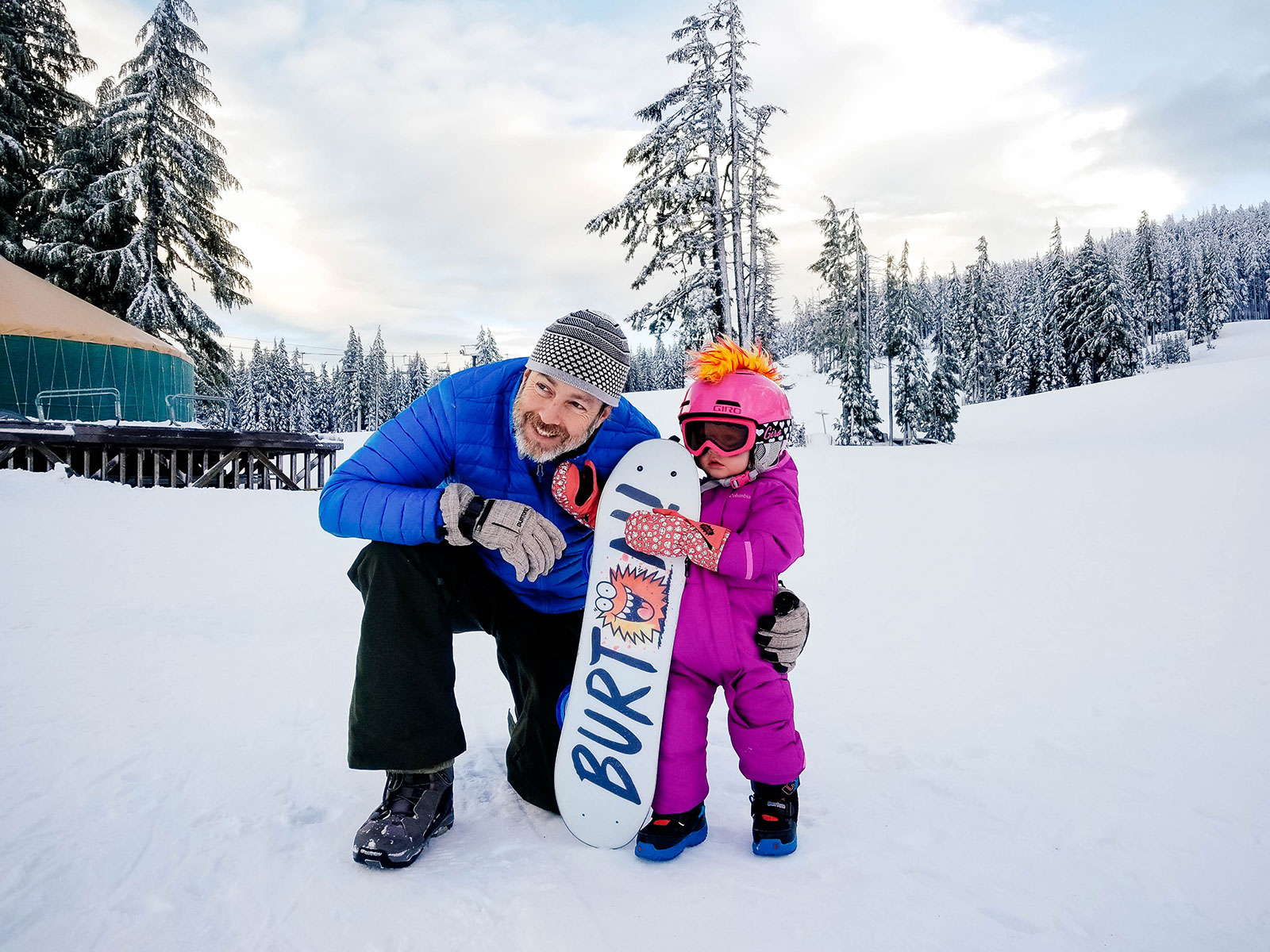
I paired the Mini Grom Rocker snowboard with Burton Mini Grom bindings, which have a single strap and oversized buckle that my toddler figured out quickly.
I like the Burton After School Special as well, since it comes with the board and bindings as a set (no need to buy and mount separate bindings).
All boards in the 80cm to 110cm range are Burton Riglet Reel-compatible, so they have pre-drilled holes for easy attachment.
Snowboard boots
I put my daughter in Burton Mini Grom snowboard boots (size 8C) when she was 10 months old. It’s not the smallest size that Burton makes, but not so loose that a doubled-up layer of thick winter socks can’t fix.
At 10 months old, her shoe size was between infant/toddler sizes 2 and 3. So obviously, snowboard boots in size 8C were much bigger than she needed, but we never had a problem with fit since kids at this age have no idea how snowboard boots are supposed to feel.
Their feet are solidly locked in place with the bindings, they don’t need to buckle/unbuckle repeatedly the way we do, and they’re not doing much walking in the beginning.
Most likely, you’ll be carrying your child to the lift and across the snow when they’re first learning. If you feel the boots are too loose for your liking, you can always stuff the toes a bit.
What I really like about the Mini Grom boots are that they come with Burton’s Room-To-Grow footbed, which can be removed to extend the boots one full size. So, we were able to use the boots from 10 months to 4 years on our first daughter.
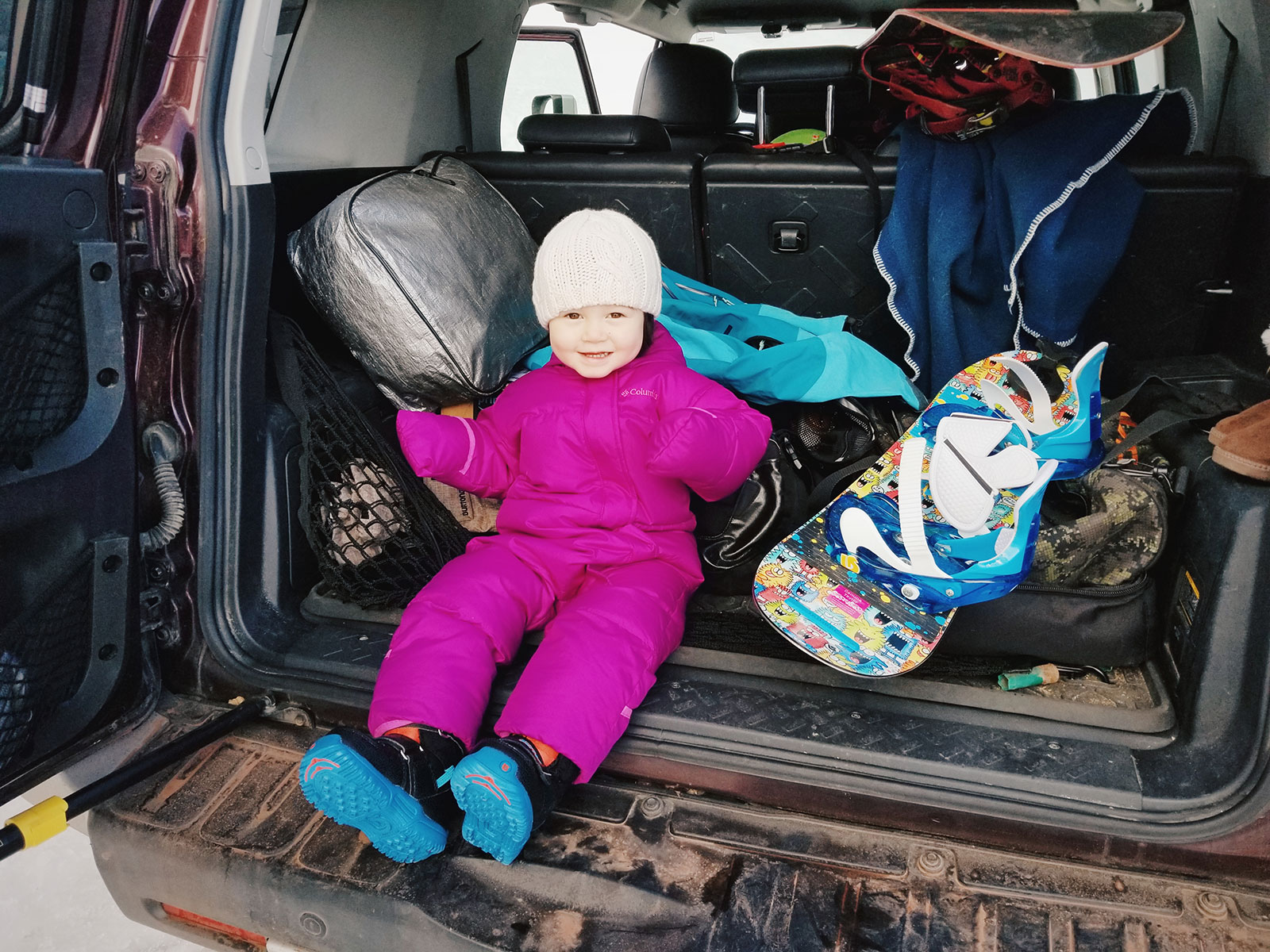
Can you use hard-soled snow boots like Sorel? Sure, but I don’t recommend it unless you’re just playing around. Toddler boots are so tiny, I found they constantly slipped inside the bindings, which can only cinch down so much.
So, I suggest buying proper snowboard boots one or two sizes larger, and if they’re the Mini Grom boots, they’ll grow as your kiddo grows. (Which we know happens way too fast!)
Helmets and goggles
A properly fitting helmet is important, and my favorite is the Giro Launch. It’s lightweight, easily adjustable, and comes in tons of colors so my daughter can pick her favorite and feel the stoke of winter coming!
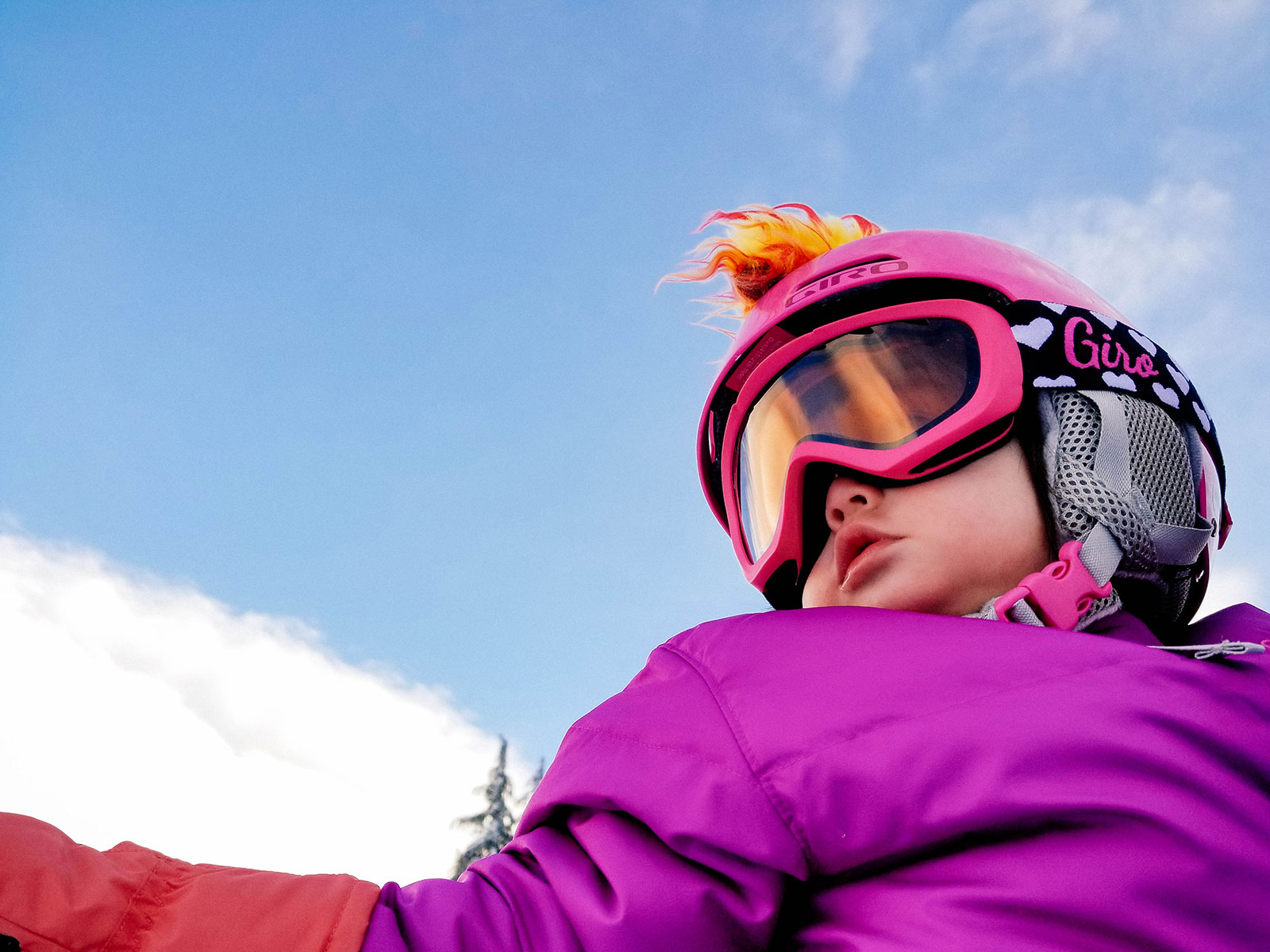
We paired this helmet with pint-sized Giro Chico goggles, but you can also get the Giro Launch Combo, which sells the helmet with matching goggles together as a set.
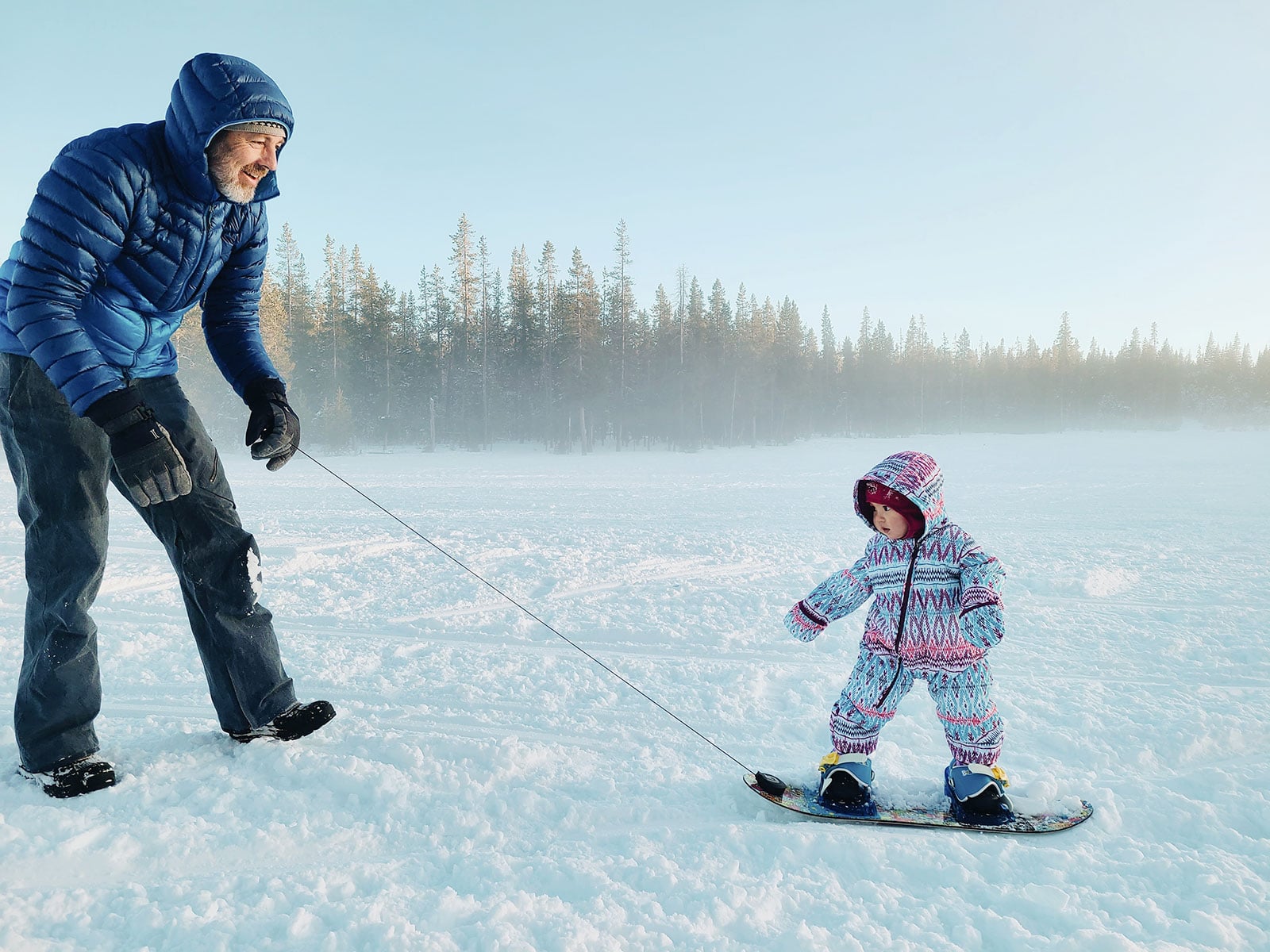
Essential gear checklist:
- Burton Mini Grom Rocker snowboard or MDXONE x Burton 80cm toddler snowboard (or try one of these kid-friendly alternatives)
- Burton Mini Grom bindings
- Burton Mini Grom snowboard boots
- Giro Launch helmet
- Giro Chico goggles (or get the Giro Launch Combo)
Favorite training tools for teaching a toddler to snowboard
Ski accessories for teaching have moved beyond using hula hoops and ropes to reign your kid in as you guide them down the hill.
These days, specialized training tools help little kids get the hang of snowboarding faster, and these three are our favorites.
Tow reel
We have the retractable Burton Riglet Reel attached to our daughters’ first snowboard and it makes it super fun (and easy) to pull them around the yard, house, and bunny hill as they’re getting used to sliding sideways the first couple years.
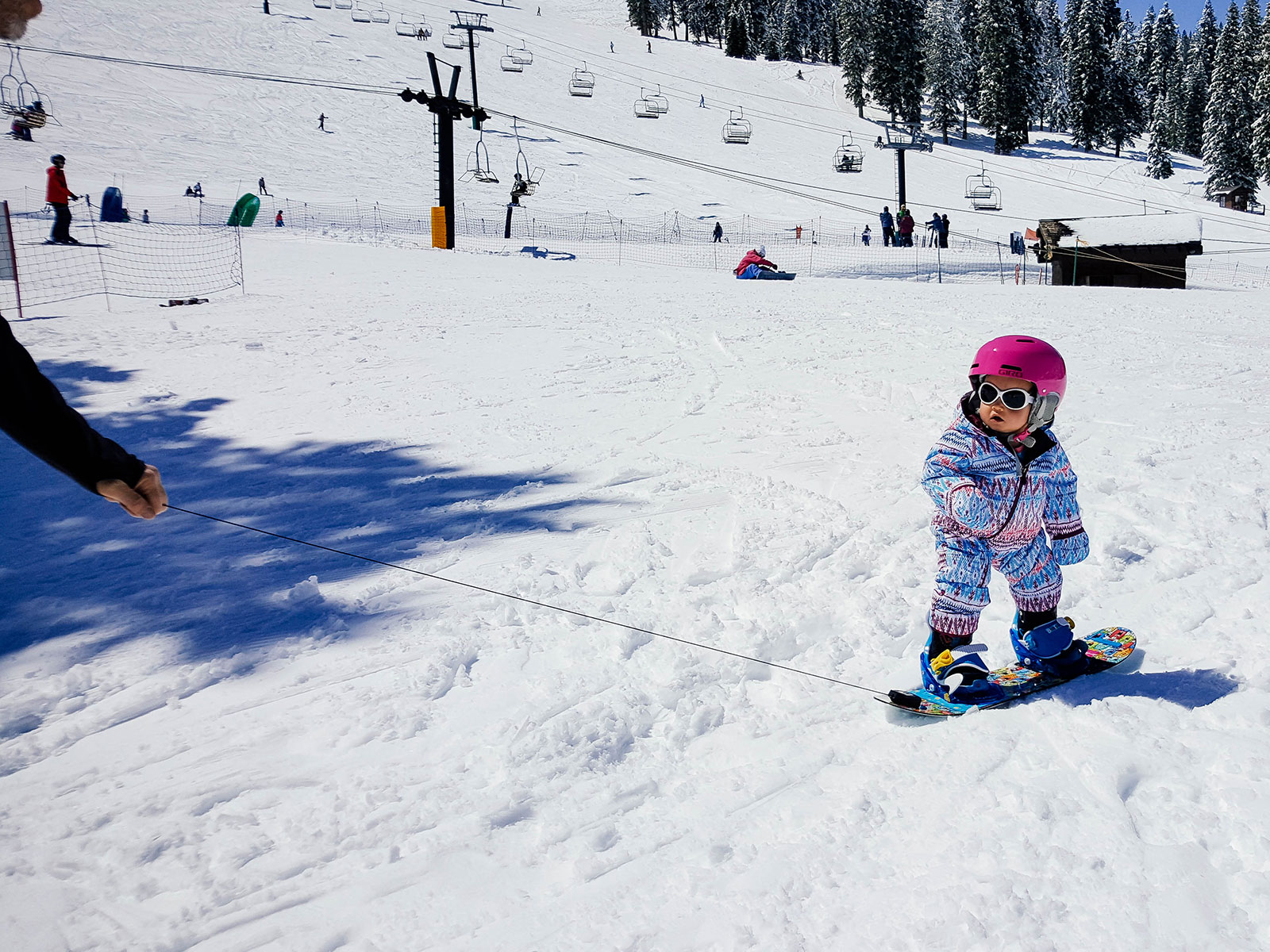
It’s also useful for pulling your kiddo back to the lift line so you don’t have to unstrap them.
Backpack harness
We were introduced to the MDXONE by a friend and can say it made a big difference in how we were able to teach our daughter to snowboard.
Before this, my husband would snowboard right next to her (on her heelside) while holding her up—it’s a back breaker (for him) and not very effective in the long run.
With her wearing the MDXONE (a backpack that acts as a tether), he could snowboard naturally, stay as close or far as he needed to, and control her speed without tripping either of them up.
I should add that you need to be a fairly advanced rider to be able to do this, since it’s hard to predict which way your child will turn on a snowboard (especially when she’s not on a fall line).
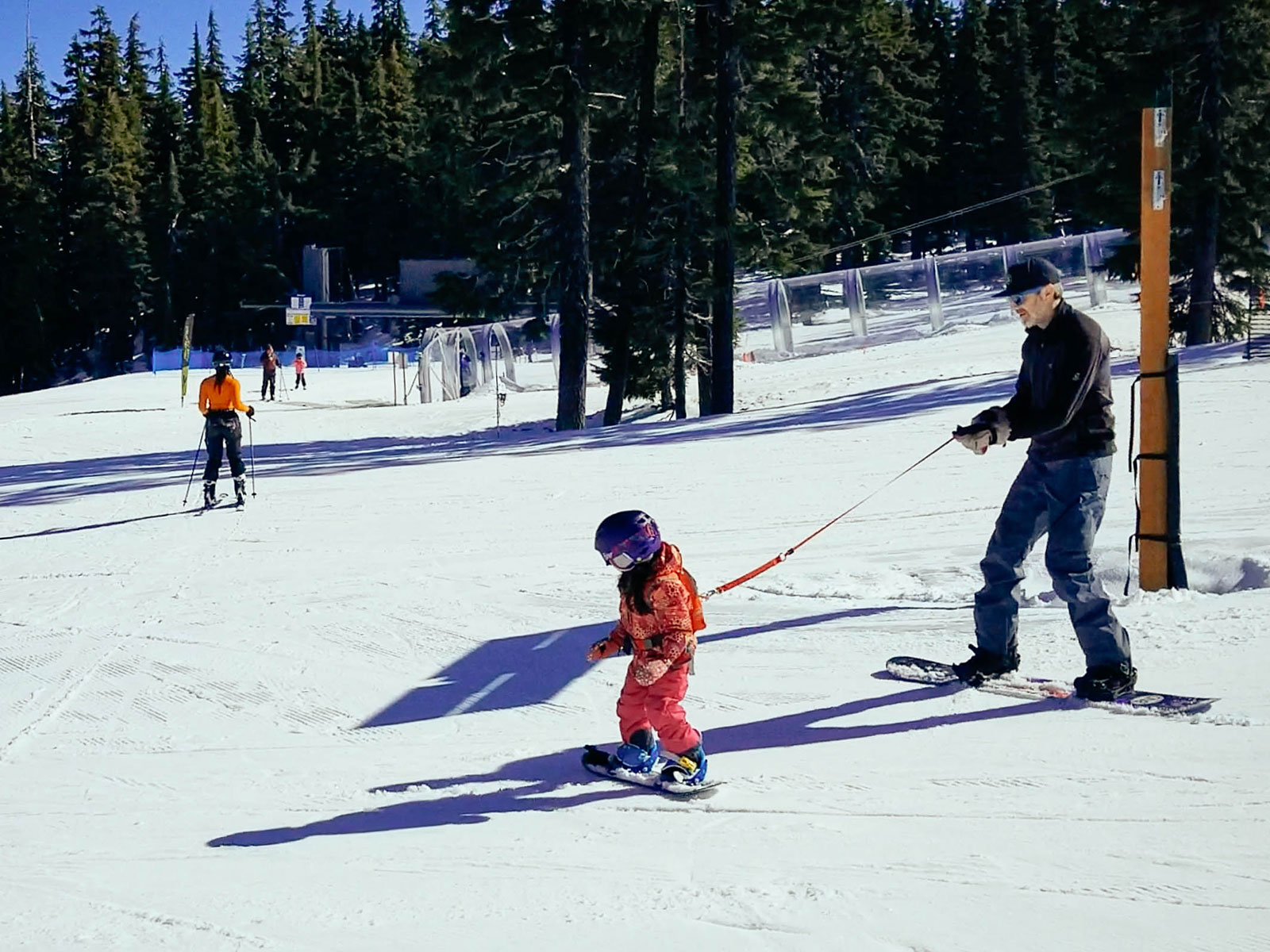
The MDXONE is a small backpack with a variety of attachments to aid in training: a grab handle, retractable leash, and bungee cords. Using it has helped us help her with getting off the chairlift, initiating turns, and slowing down on steeper sections.
And best of all, she can carry her own bribes, I mean, snacks for the mountain.
Milo communicators
This is a recent purchase for us as our kids progress on their snowboard journeys, and we’re really excited about the possibilities.
The Milo is a hands-free “action communicator,” as the company calls it—essentially a walkie-talkie that eliminates the push-to-talk feature.
You simply pair your Milo communicators so they’re on the same mesh network, attach to your jacket, and enjoy natural conversations with your group—all without pushing a button, searching for your phone in a pocket with gloved hands, or yelling over your shoulder.
You just talk, and your riding buddies with Milos can hear you as if you were right by their side.
We’re not at the point yet where we’re separating from our kids on the mountain, but Gemma is starting to go much faster ahead of us (especially if we’re guiding Ember down slowly). With the Milo, we can tell her to wait for us, slow down, keep her speed across a flat section, watch for another skier, or simply cheer her on as she links her turns.
Before we had the Milo, we had to stay close to hear each other, but that gets tougher as the kids get better. Now, we can all go at our own pace and carry on conversations at normal volume.
We’ve found that the Milo makes our runs safer as we can give turn-by-turn directions or warnings (for example, if our kids are about to overshoot the “get back” trail) in real time.
Not surprisingly, they love using the Milos when they snowboard, and for us, it’s also really fun to hear our kids talking to themselves as they go down a hill!
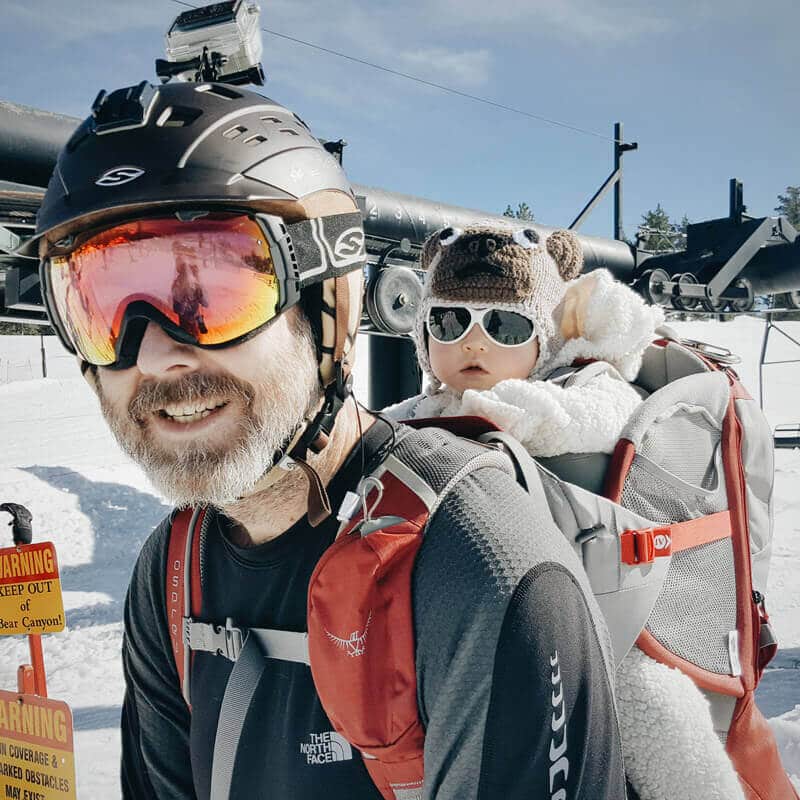
Teaching accessory checklist:
How to introduce a baby to snowboarding
From ages 1 to 2, it’s all about having fun and getting used to snow. Sledding, snowball-making, and gentle introductions to the snowboard are key, and zero instruction takes place.
One of our favorite things to do at this age was seating Gemma on the board (between the bindings) and using it as a mini sled. That got her familiar with her own board, and piqued her interest in the buckles, straps, and graphics (and how they looked just like Mom and Dad’s boards).
As a baby, she also hitched a ride in this baby backpack carrier as my husband hiked up a small hill and snowboarded down to the parking lot, getting her used to the thrill of flying down a run and feeling the wind in her face.

For us, the first year or two was simply about generating stoke, no matter what shape or form our snowplay took.
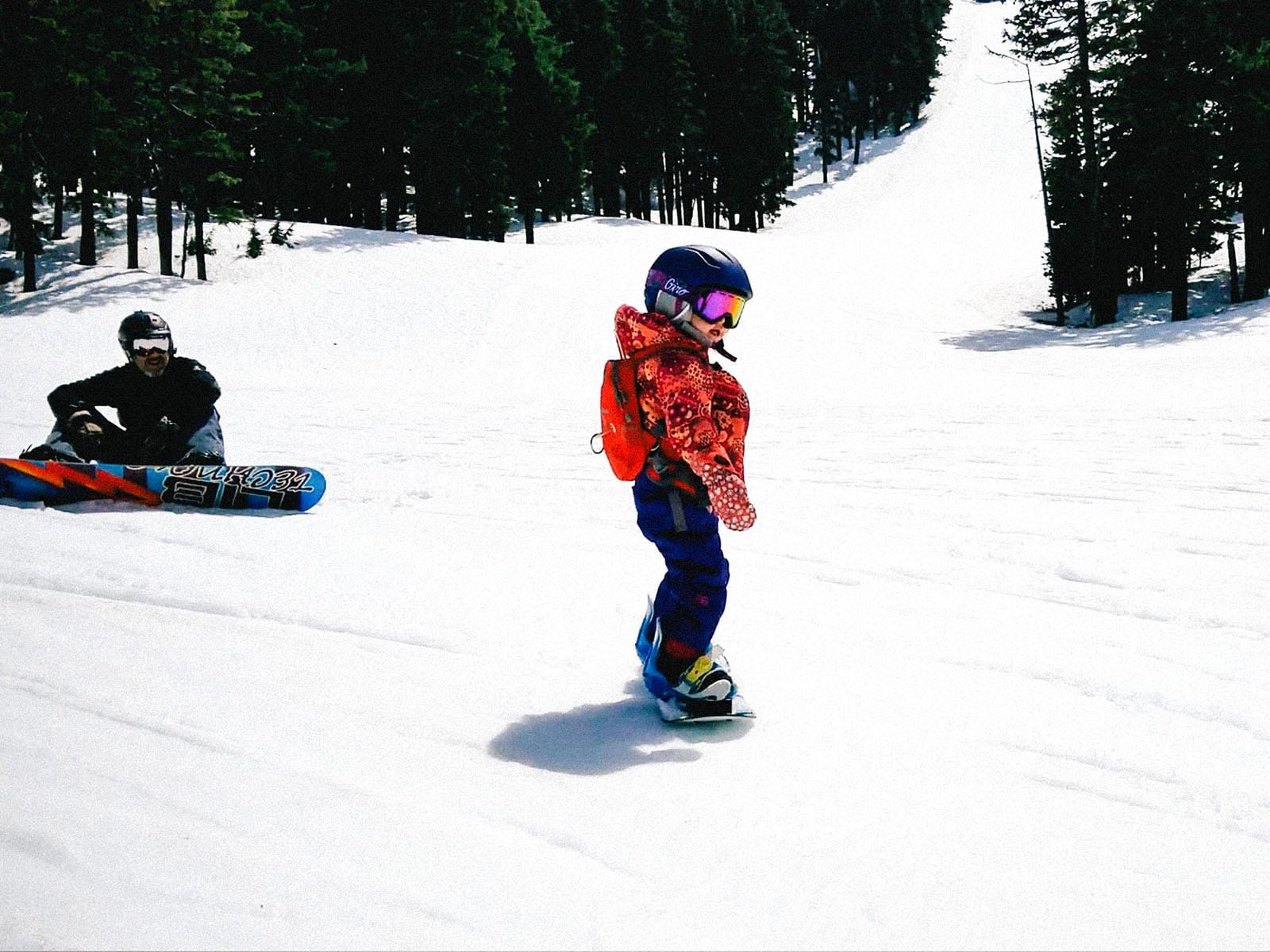
How to teach a toddler to snowboard
From ages 2 to 5, when kids are able to understand simple instructions and develop edge awareness, you can start teaching them how to snowboard.
This is the basic progression we used with our older kiddo (now 7 years old and snowboarding independently) and the same steps we’ll take with her younger sister.
Step 1: Pull them around the house.
In fall, we like to get the snowboard out and pull our kid around the house (on carpet) or around the yard (on grass) to introduce (or reintroduce) the concept of sliding sideways. Think of it as a guided exploration and turn it into a game!
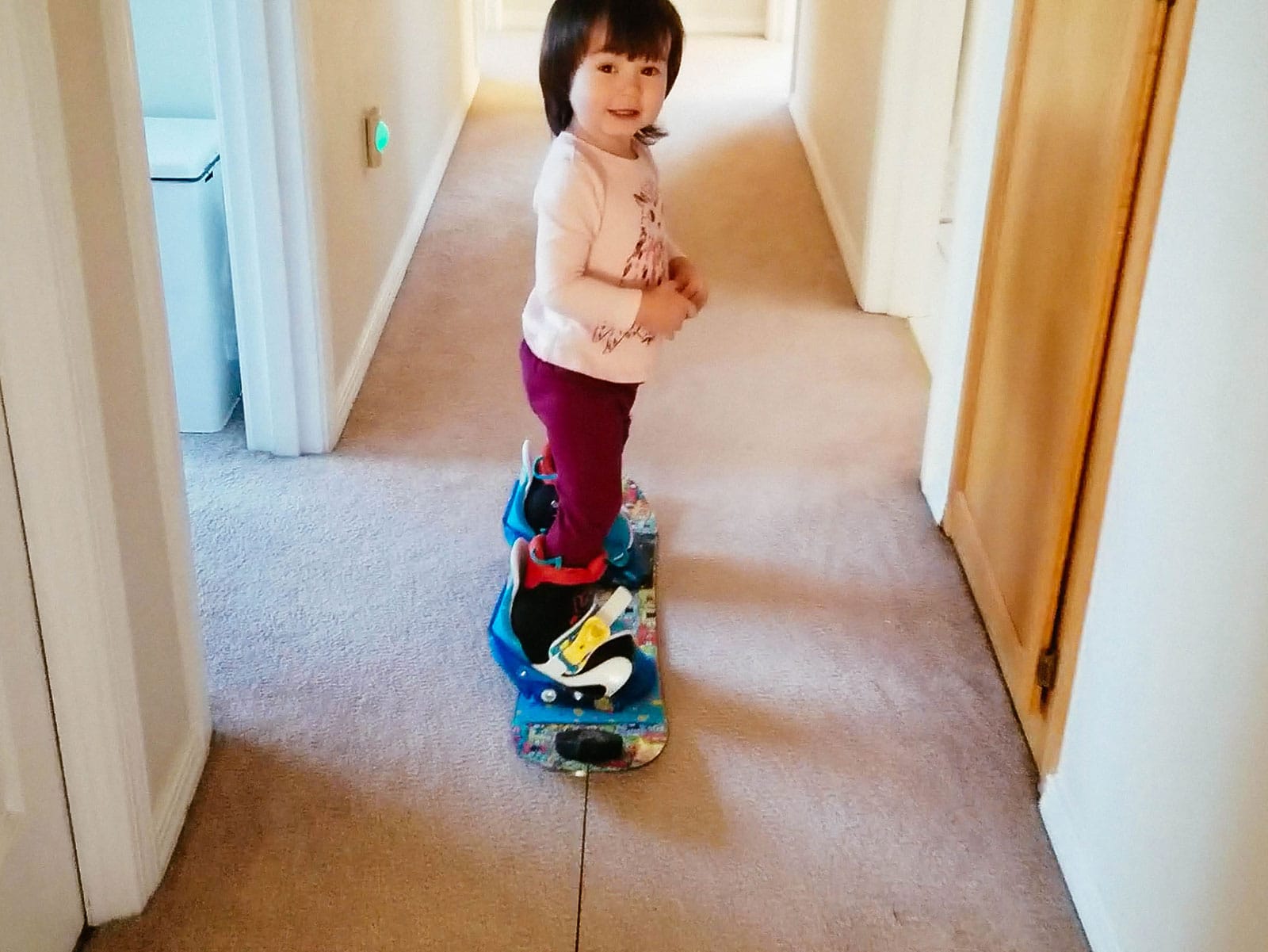
This provides endless entertainment as you can pull your kid around corners, up and over mounds, and all over the yard looking for treasures. The Riglet Reel comes in really handy for this, but you can also rig something up with rope.
Try to vary your speed to get your little ripper used to riding on land. When your child is able to stay relatively balanced over uneven terrain and understands what it means to stay low (squat), you’re ready for the next step.
Step 2: Give a gentle nudge-and-catch.
In the beginning, it’s much easier to teach your little one the basics of snowboarding when you, yourself, are not strapped in. Your patience will go a lot farther when you’re not constantly unbuckling your bindings to rescue your kiddo.
Look for a small, mellow hill where one parent can stand at the top (as the nudger) and one at the bottom (as the catcher). Position your child directly down the fall line and give a gentle nudge toward the other parent.
All you’re looking to do here is have your toddler glide down in a straight line, unassisted, into the catcher’s arms.
It’s important to choose the right kind of slope for this, as you don’t want to scare your kiddo with a high-speed wipeout or a glide that’s faster than your kid is comfortable with.
I recommend sticking with a distance of 10 to 25 feet at most; you want your kid to squeal for more, not less.
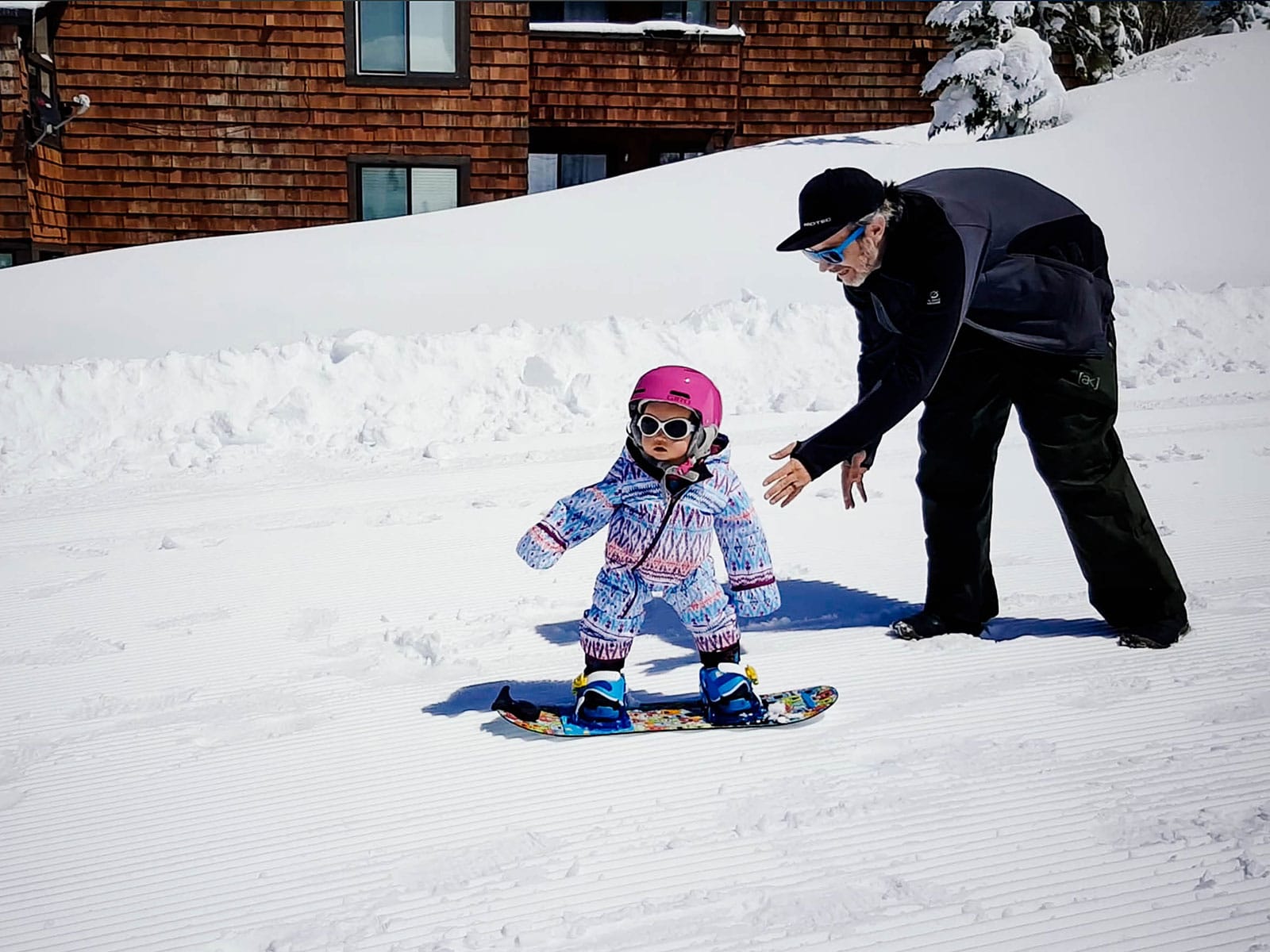
If you’re teaching your toddler solo, find a hill with a long, flat runout at the bottom. This allows your kid to come to a stop independently without a “catcher” person.
You can also manage your toddler’s speed by using the Riglet Reel from behind. Your kid will end up going switch (since the reel is attached to the nose), but at this stage, it doesn’t matter.
While we’re playing in the snow, we love to psych our kiddo up and have her do little hops on her board, or lean waaaay back and waaaay forward just so she has a good feel for how far she can take her board.
Step 3: Practice heelside slipping.
Once your toddler’s gotten the hang of gliding down, the real fun begins!
Start training your child to squat with the snowboard very slightly angled down the slope.
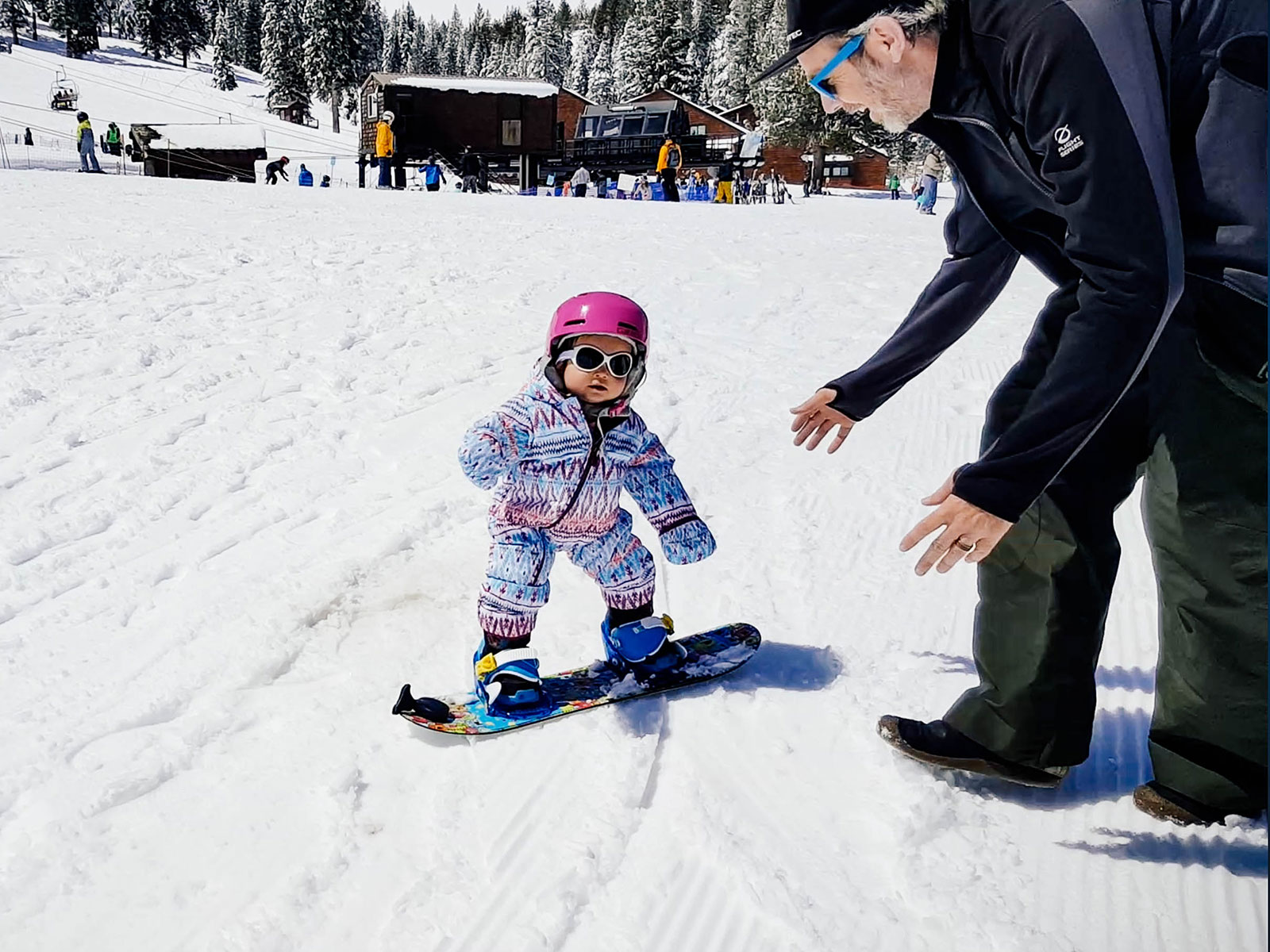
You can stand in front of the board and lightly hold your toddler’s hands to boost confidence as you guide the board downhill.
Use simple instructions like “lean back” or “stay low” to help your toddler slow down, and “hands out” to help with balance.
Help your kids do “falling leaf” down the slope this way and progress onto managing their speed with the MDXONE harness, if you have one.
Whatever you do, try to resist the temptation to hold your kids from behind for the whole lesson. They usually end up floppy like a ragdoll as they lean on you for support.
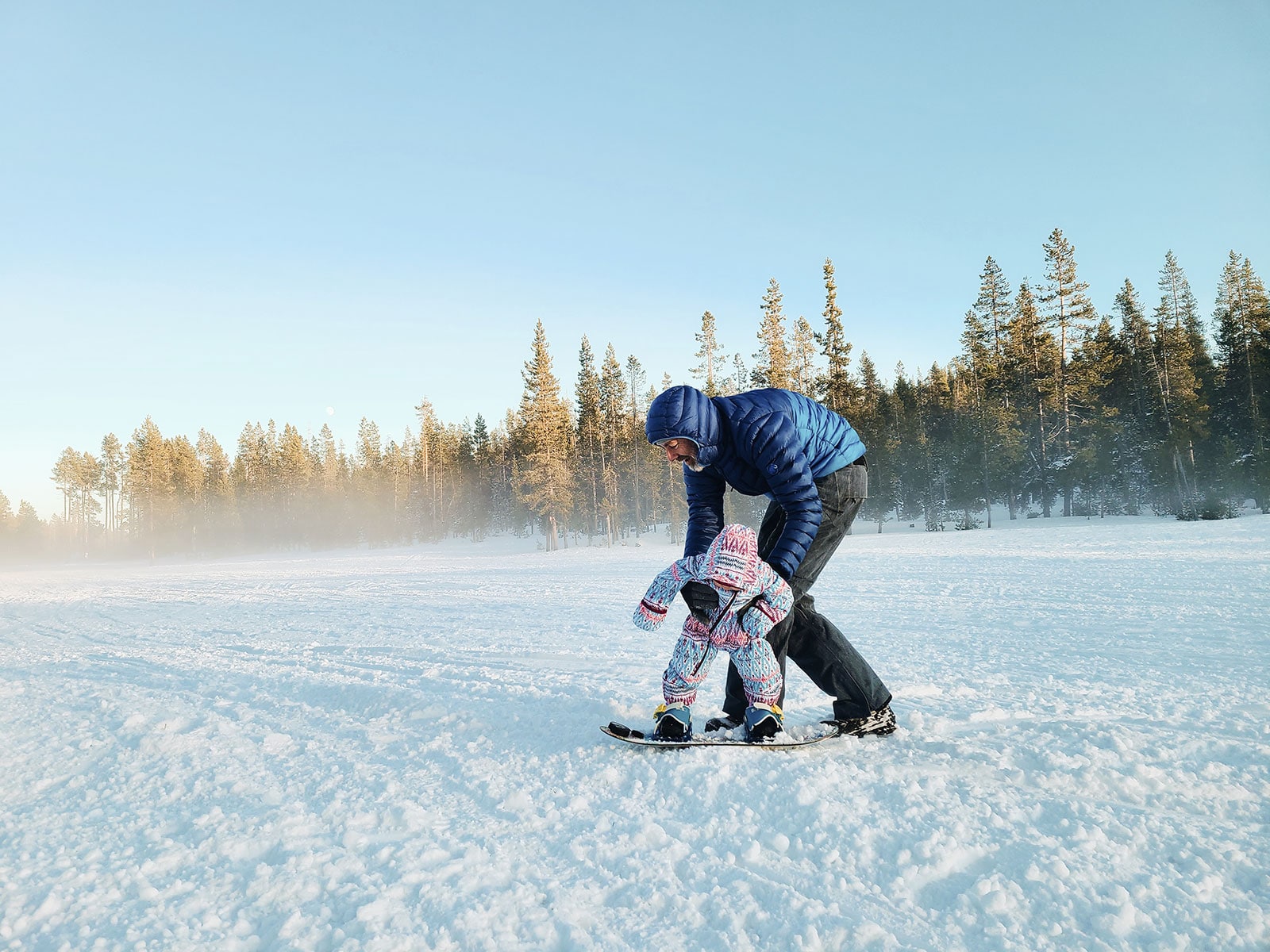
You want to encourage them to stand on their own, plus they’re always more confident when they can see you.
Once your kids are comfortable going heelside across the mountain, teach them to lift their toes so they can practice going on edge.
Lifting their toes also helps them prepare for the “hockey stop” (coming to a stop while balanced on their heelside edge).
Step 4: Practice toeside slipping.
For toeside, have your child face back up the hill and squat on the board.
Like heelside, the board should only be slightly angled down the slope. Help your toddler slide across the hill this way with hands in the snow for balance.
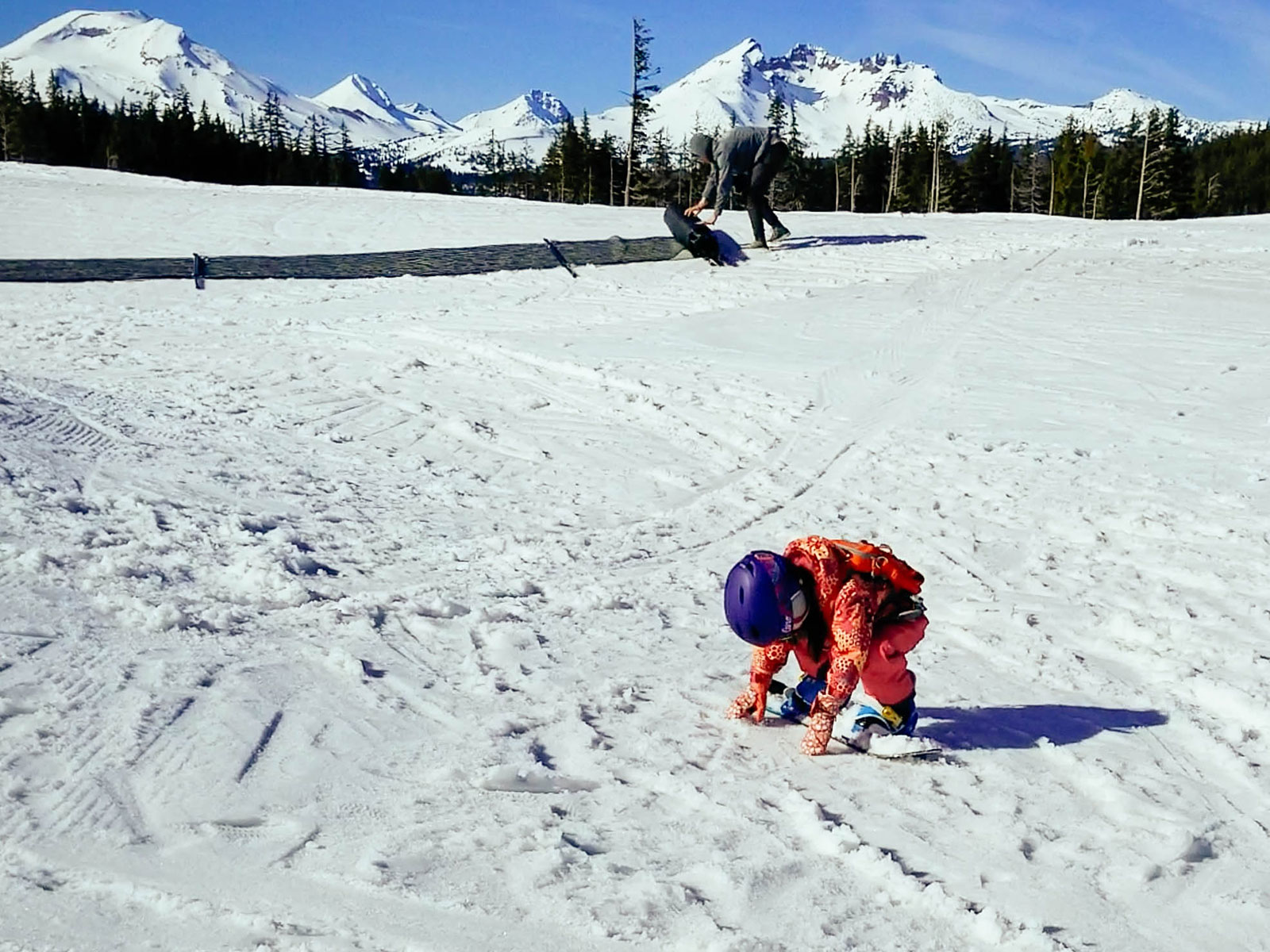
As your kids gain confidence in this stance, gradually increase the downhill angle of their toeside slipping to a point where they’re not relying on their hands in the snow as much, and are lifting their heels naturally. (And always remind them to stay low!)
Toeside is generally more difficult for anyone to learn, so remember to keep things fun! Take little breaks for snacks, and point out things like animal tracks in the snow, other kids snowboarding, fun costumes on the hill, anything that keeps your kiddo curious and excited.
You’ll probably stay at Step 4 for a while, as toeside takes a lot of practice to do correctly and many kids revert to doing falling leaf. Don’t feel discouraged!
Step 5: Progress to an S-turn.
How do you know when it’s time to start making turns? This will depend entirely on your toddler’s ability and comfort level.
When your kids can confidently control their speed on both edges, they’re ready to move on to turning.
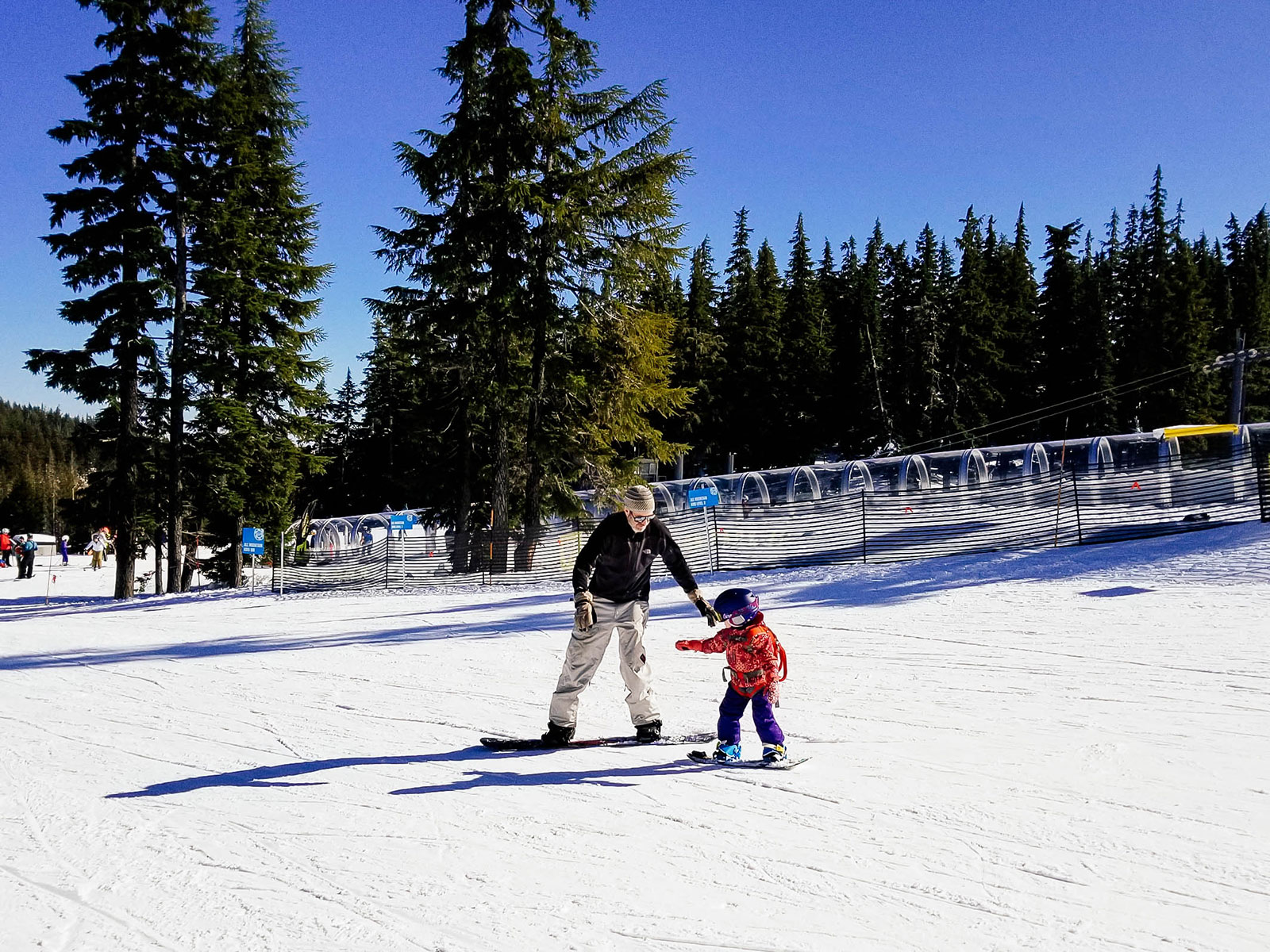
Our older daughter began understanding how to link turns when she turned 4 (in her third season) and continues to work on linking turns more smoothly at 7. The MDXONE backpack helped immensely, and once she got her heelside and toeside down, we were able to shred the bunny hill with her leading the charge.
It’s awesome to watch your kids progress each winter, even if it’s off the slopes—like toddlers suddenly wanting to be like the big kids and carry their own boards.
Before you know it, they’ll be asking for season passes for Christmas and dusting you in the pow!
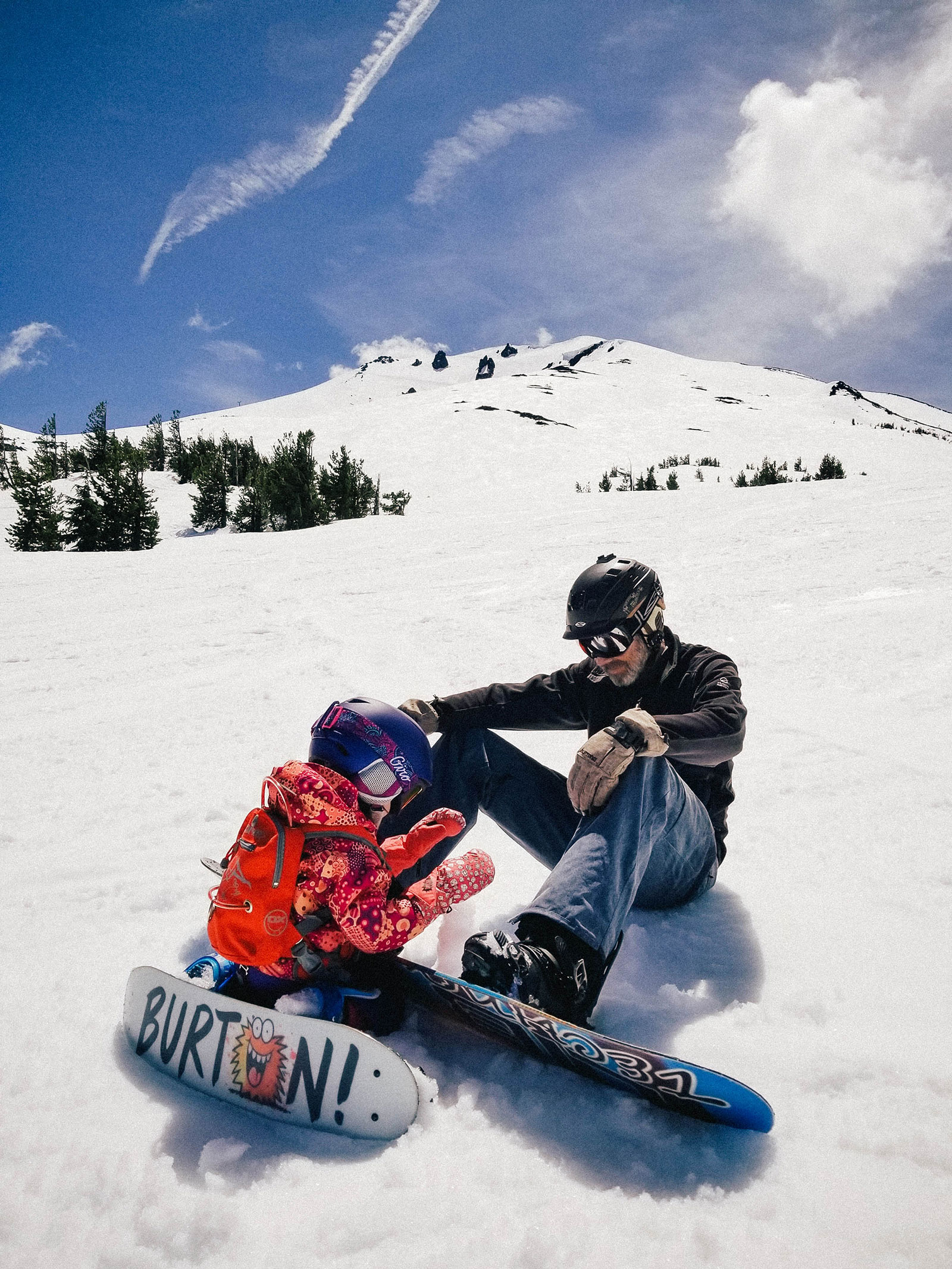
More tips for teaching your kids and having a blast together
We typically teach our kids on sunny groomer days. It’s just more enjoyable for everyone, as we (the grown-ups) aren’t frothing to get out there on a pow day, and the kids aren’t frozen and blinded on a storm day.
March through May is when we really pick up the pace on lessons, as all that slushy spring corn is soft and forgiving for beginners. It’s easy and positive to ride on, without the pain of falling on icy hardpack or the frustration of digging out of deep powder.
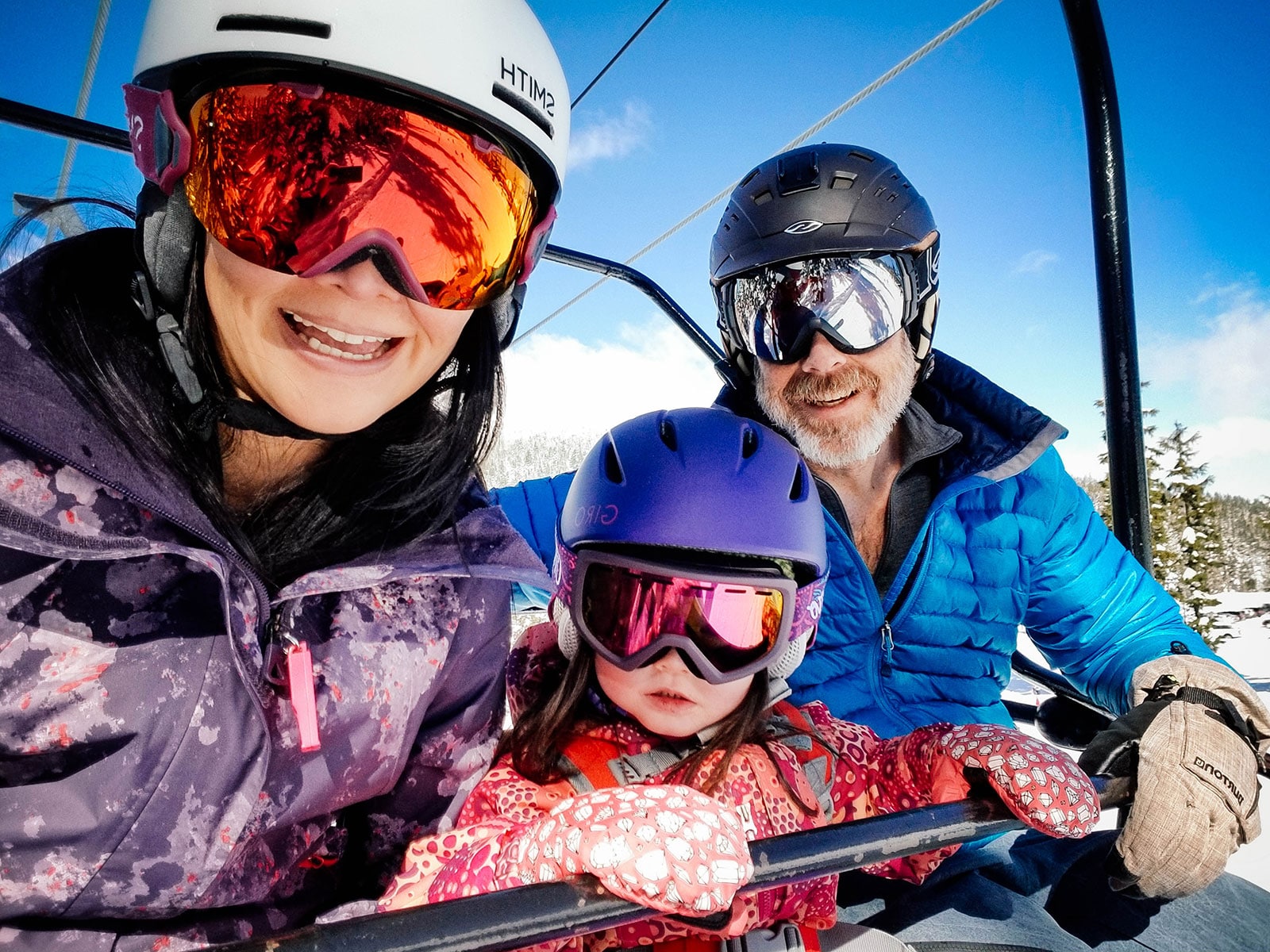
My husband and I love playing on natural terrain features and riding through trees, and it’s something we hope to instill in our kids.
Tree runs are really fun opportunities to make up stories about imaginary forest creatures, and natural gullies (or baby-sized halfpipes) are perfect places to help them practice going side to side and up and down the walls without fear of falling off a cat track.
If your local resort has a beginners’ terrain park, let your kids play and explore features that help improve balance and maximize their stoke of being on the mountain.
At the end of the day, one of Gemma’s favorite things is riding between her dad’s legs on his board so she can “Go faster! Go faster!” down to the parking lot.
There are definitely days when the kids just want to build snowmen, slide down hills on their butts, or head to the lodge for hot chocolate after just one run, and that’s okay too. As long as they’re smiling and begging to go back by the time we leave, I’m all for it.
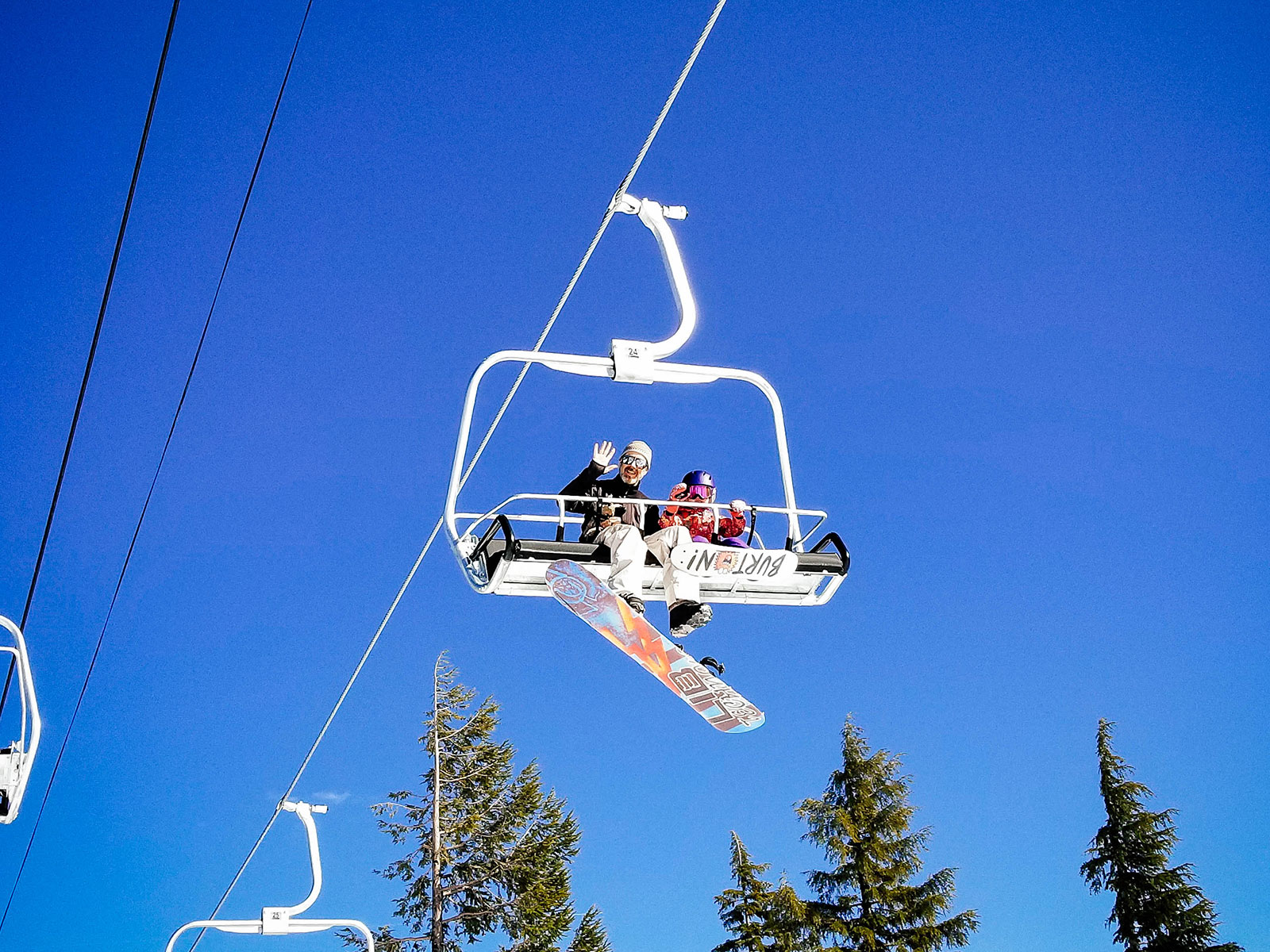
Here’s a fun video showing our older daughter Gemma’s progression from 10 months to 4 years old.
This is a video of our younger daughter, Ember, at the end of her first snowboard season when she was just 19 months old.
Maybe it’s ’cause she’s the second child and always trying to keep up with her older sibling, but Ember was pretty fearless so we actually took her on relatively long runs on the bunny hill during her first winter.
By the time the season ended, she was able to glide down by herself and instinctively squat and balance on her board. And by the next season when she was 3 years old, she was asking to ride the “big” lift with us (even though she was still learning how to falling-leaf her way down the trail).
Sure, she had a few minor spills (and going down her first real green run took a very long time with a lot of patience needed on both sides). But with all of us fueling the stoke, she always got back up with big smiles and asking to go one more time.
This winter, we’re excited to see how she progresses with more lessons from Dad!
Common questions about teaching toddlers to snowboard
Can a 1-year-old really learn how to snowboard?
Yes, but not learning in a traditional sense. Both of our daughters got on a snowboard at 10 months and 14 months, respectively. But at this age, the skills they learn are more intuitive, like squatting and balancing on a board.
When you start “teaching” your 1-year-old baby how to snowboard, you’re really just getting her out in the snow with the rest of the family, which is infinitely more fun than sitting in the lodge all day.
Can a 2-year-old really learn how to snowboard?
Absolutely!
At 2 years old, toddlers can start to figure out a few things, even if they’re not able to communicate well—things like staying low, leaning back, and holding out their arms for balance, all of which are foundational skills they’ll need to eventually master the sport.
Thanks to their fearlessness and low center of gravity, it’s easier to teach a toddler to snowboard than an older child or adult. The sooner you get your kids in the snow with their own gear, the more comfortable they’ll be with the idea of snowboarding as they get older.
Can you carry babies in backpacks on the chairlift?
Most ski resorts don’t allow babies to be taken on the chairlift in a baby carrier or backpack due to liability. The general rule is that every person loading onto a lift must be strapped into skis or a snowboard.
That means you can’t carry your child’s board while walking him on, nor can you carry him and his board onto the lift.
However some resorts do allow babies onto a gondola, so it’s wise to call ahead and find out the resort’s policies as far as taking your baby on the mountain in a backpack.
My advice? Hike up a mellow hill with your baby on your back and then snowboard down to get her used to the feeling of gliding through snow!
How do toddlers get on a chairlift?
First of all, if you have the option, take your toddler on the magic carpet (surface lift) first. These moving walkways typically access the easiest terrain at a ski resort, so they’re a good place to get your toddler familiar with loading and unloading.
When your child is ready to progress to a chairlift, make it an exciting event.
“Okay, we’re going to ride on the big chair now! Let’s watch the chairs and when I say go, we’re going to chase after the chair in front of us and stop when we get to the red line.” (Or yellow or blue or whatever color the line is.)
Most lift operators will slow down a chair when they see little kids loading, but you can always remind them if your toddler is nervous about getting on.
It’s challenging for kids under age 5 to unstrap and skate on their boards when they’re just starting to learn basic skills, so this is where something like the MDXONE comes in very handy.
With your toddler positioned on your frontside, skate/slide both of you through the loading zone and then use the grab handle on the MDXONE backpack to lift your child onto the chair. Make sure your child is seated all the way back.
“As soon as we get on, I’m going to put a bar down and then we’re going to go super high in the air so we can get to the top.”
Lower the safety bar and remind your toddler to enjoy the view, but to sit as far back as possible. Chair rides are always a good time to break out some snacks!
How do toddlers get off a chairlift?
Lift operators generally slow down a chair when they see little kids unloading, so as the chair approaches the off-ramp, raise the safety bar and keep a good grip on your child.
(If your toddler’s wearing an MDXONE harness backpack, this is where the grab handle comes into play.)
“Okay, when we get to the top, I’m going to lift the bar and when I say go, we’re all going to get up together. As soon as we stand up, we’re going to scoot away as fast as we can so we’re not in the way of the people behind us.”
Get a firm hold on your child’s grab handle and skate/slide both of you down the ramp and off to the side.
When do you transition kids from the bunny hill to a more moderate hill?
In our opinion, as soon as your kids are comfortable on their snowboards. If you snowboard, you know that speed is your friend—it’s easier to get going and make turns when you have a little momentum.
Going too slow, even though it seems safer, can really hinder progress and actually make snowboarding more challenging than it should be.
So find a good compromise between how confident your toddler feels on her board, and how steep the green or blue runs are at your resort, compared to the part of the mountain where you’ve been teaching the basics.
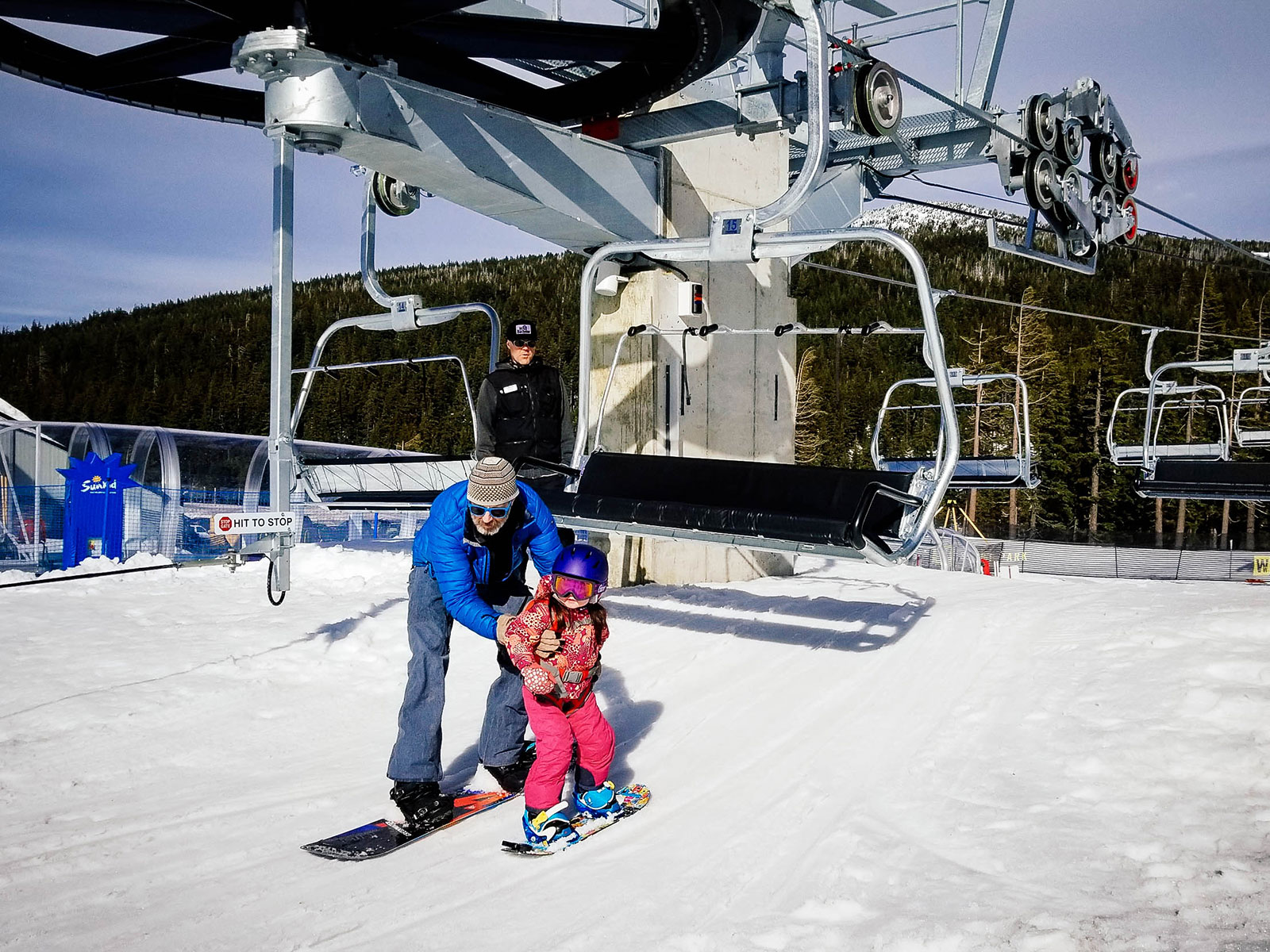
Do little kids need wrist guards and protective pads?
Additional protective gear like wrist guards and tailbone pads are always a good idea, but in my opinion, aren’t necessary for little kids who are just learning how to snowboard.
They usually aren’t going very fast, and if they do pick up speed, it’s often for short enough distances (on relatively flat terrain) where a tumble isn’t going to result in injury—aside from a bruised ego.
Where to buy toddlers’ and kids’ snowboarding gear
[show_shopthepost_widget id=”5125065″]
Burton Mini Grom Rocker Snowboard | MDXONE x Burton 80cm Toddler Snowboard | Burton Mini Grom Snowboard Bindings | Burton After School Special Snowboard | Burton Mini Grom Snowboard Boots | Giro Launch Snow Helmet | Giro Chico Snow Goggles | Giro Launch Combo Helmet with Matching Goggles | Burton Riglet Reel | MDXONE Ski and Snowboard Harness Trainer | Milo Action Communicator | Osprey Packs Poco Plus Child Carrier | Baby Banz Retro Banz Sunglasses
This post updated from an article that originally appeared on February 3, 2017.
View the Web Story on how to teach toddlers and little kids to snowboard.


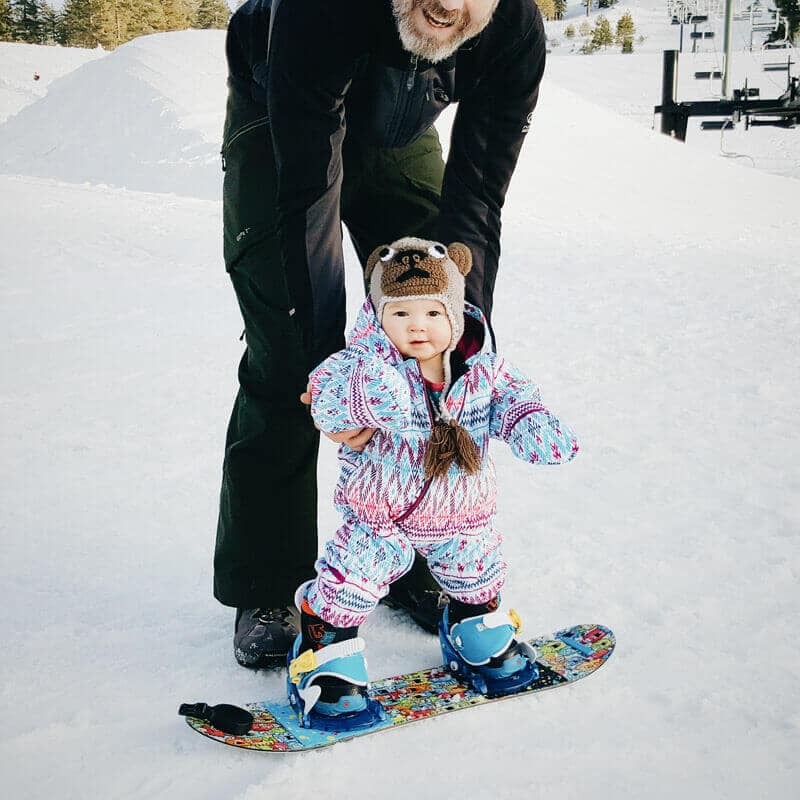













I love this! I’ve been snowboarding with my wife for over ten years with no kids. Well now we have a toddler and this has been quite helpful! Thank you Linda
We’re wanting to take our son next season when he’s around 15-18 months old, so we’re looking for some end of season/2nd hand gear now. What size board would you recommend? 80, 90 or 100cm?
I recommend starting with 80cm which should last him at least 2 seasons (unless he’s very tall). Both our daughters were in 80th percentile for height and they started on 80cm at 1 year old—the older one then moved on to 100cm at 4 years old (she skipped 90cm).
Where did you get the board in the picture “Teaching our first daughter how to slide down on her heelside at 1 year old.”
What a beautiful family mate. So glad you guys had a good time. I wanted to ask if you knew if the After School Special board is any different to the Chopper?
Thanks!
Thank you Jake! The difference between those two boards is that the Chopper does not have bindings pre-mounted (you have to buy and mount them separately). The Chopper might also have a more convex base, but I’m not 100% certain.
Hi,
Could you tell me how big were the sizing from 10mth to 4 years boots and binding?
Looking to introduce my kid to snowboard and looking to buy equipment. She will be 18 mths this winter but still wearing size 3 in shoes! No way a 7C (smallest in burton) will fit. How did you manage the sizing from bigger size for those 4 years?
Thank you
I am curious to know too!! My daughter is also in size 3 shoes!!
Bigger boots actually help with balance and stability because of how high they go up the legs to sort of lock them in place. We just doubled-up on thick winter socks the first year or two, but you can even stuff the toes if you need to.
I think your daughter will be fine in 7C. At this age, they have no idea what snowboard boots are supposed to feel like, their feet stay solidly in place since they’re strapped in, and they’re not doing much walking in snowboard boots anyway (since you’ll likely be picking them up and moving them around on the snow during your lessons). Good luck and have fun!!
Bigger boots actually help with balance and stability because of how high they go up the legs to sort of lock them in place. We just doubled-up on thick winter socks the first year or two, but you can even stuff the toes if you need to.
I think your daughter will be fine in 7C. At this age, they have no idea what snowboard boots are supposed to feel like, their feet stay solidly in place since they’re strapped in, and they’re not doing much walking in snowboard boots anyway (since you’ll likely be picking them up and moving them around on the snow during your lessons). Good luck and have fun!!
you really beat that 12-month and 18-month old! agh. hope this girl isn’t an introverted bookworm type…
LOL no competition, we just felt she was ready. And FYI her dad and I are both introverts… I think a lot of outdoorsy people are. I’m also a bookworm. 🙂